Constraining the Passive to Active Margin Tectonics of the Internal Central Apennines: Insights from Biostratigraphy, Structural, and Seismic Analysis
Abstract
1. Introduction
2. Geological Setting
2.1. The Central Apennines
2.2. The Volsci Range and the Latin Valley
3. Materials and Methods
3.1. Stratigraphic Review and New Paleontological Determinations
3.2. Structural Analysis
3.3. Borehole Data from the Latin Valley
3.4. Seismic Dataset
4. Results
4.1. Stratigraphic Constraints
4.1.1. Stratigraphic Review
4.1.2. New Stratigraphic Constraints
4.2. Structural Analysis of the Volsci Range
4.2.1. Thrusting at the top of Lower Volsci Unit
4.2.2. The Volsci Range Thrust Front and the Latin Valley Structures
4.2.3. Backthrusts and Normal Faults
4.3. Seismic Interpretation of the Latin Valley
5. Discussion
5.1. Chaotic Complex Emplacement and Thrust Propagation
5.2. The Late Stages of Shortening
6. Conclusions
- Late Cretaceous extensional tectonics. The dismembering of the carbonate platform into shallower and deeper domains is constrained by the finding of crustons that may testify moments of subaerial exposure, characterizing the top of the Lower Volsci UnItal. Cave exploration and field mapping allowed us to recognize a previously unreported fault-controlled paleo-escarpment constituted by Cretaceous and Jurassic carbonates sealed by early Miocene deposits that were previously dated as middle Miocene. These units seal a hardground settling on a platform edge facing to the west, where basinal to bypass slow-rate sedimentation occurred till Burdigalian time.
- Tortonian Chaotic complex emplacement (Thrust-1) and foreland-directed (in-sequence) thrust propagation (Thrust-2). During the overthrusting of the Upper Volsci Unit, Paleogene to Neogene basinal deposits were squeezed off towards the Foredeep and juxtaposed as a mélange unit on top of the carbonate platform together with early to middle Miocene calcareous-cherty-siliciclastics. The Chaotic complex also bears highly deformed basinal exotic and native blocks of neritic carbonates, the latter being scrapped off by the overthrust of the embedding Chaotic complex, whose Paleogene-Miocene matrix includes up to Tortonian nannoplankton. Seismic analysis supported by well logs at the regional scale highlighted repeated carbonate thrust sheets that have first been involved into an initial in-sequence propagation towards the foreland to the ENE occurred during foredeep to wedge-top sedimentation.
- Intra Messinian thrusting (Thrust-3) breached the thrust front by doubling the flat of previous thrust fronts. Subsurface data show that during alternated phases of wedge-top deposition and erosion, the Upper Ernici unit was shortened approximately 5–8.5 km in the Latin Valley.
- Messinian to early Pliocene backthrusting (Thrust-4). New biostratigraphic data constrain the thrust top deposits in the Volsci Range and in the Latin Valley, where SE-directed backthrusts contributed to the tilt and cross-cut of previous Thrust-2 and -3 structures.
- Late Pliocene to Holocene normal faulting. Post-shortening extension has determined NE- and NW-striking orthogonal normal faults or WNW–ESE-trending right-lateral transtensional faults. These faults may have locally intercepted pre-existing normal faults that had been passively transported within the thrust sheets.
Supplementary Materials
Author Contributions
Funding
Data Availability Statement
Acknowledgments
Conflicts of Interest
Appendix A
| Site n° | Group of Localities | Latitude | Longitude | Tectonic Unit | Formation | Lithology | Biomarkers | Age Range | Comments | Author |
| 1 | Gavignano R. klippe | 41°42′9.16″ N | 13°20′38.15″ E | Upper Volsci unit | DLA | limestone | Cisalveolina fraasi | Cenomanian | in situ | [147] |
| 41°42′9.16″ N | 13°20′38.15″ E | Upper Volsci unit | MVP | calcareous conglomerate | Globorotalia apertura, G. involuta, G. concinna, Globigerina falconensis | uppermost Tortonian- lowermost Zanclean | reworked | [103], this work | ||
| 41°42′9.16″ N | 13°20′38.15″ E | Upper Volsci unit | PGC | polygenic conglomerate | no data | upper Messinian (?) | [103] | |||
| 2 | Colle Cantocchio klippe | 41°34′29.48″ N | 13°0′1.49″ E | lower Volsci unit | RDT | limestone | Dicyclina schlumbergeri, Accordiella conica, Orbitoides | Campanian | in situ | [93] |
| 41°34′29.48″ N | 13°0′1.49″ E | lower Volsci unit | CBZ | calcarenite | echinid, Ditrupa, Elphidium, bryozoa, Miogypsina, Amphistegina, Operculina, Heterostegina, Lepidocyclina | Burdigalian | in situ | [93]; this work | ||
| 41°34′29.48″ N | 13°0′1.49″ E | lower Volsci unit | UAM | gray-yellowish clay | Orbulina universa, O. suturalis, O. bilobata, Globorotalia aff. Menardii, Globorotalia opima, Globorotalia scitula ventriosa, Globigerinoides trilobus, Globigerina eggeri, Globigerina cf. Bulloides, Globigerina concinna, Globoquadrina dehiscens, Globoquadrina altispira, Bolivinoides miocenicus, Valvulina pennatula italica. | upper Serravallian—Tortonian p.p. | reworked | [93] | ||
| 41°34′29.48″ N | 13°0′1.49″ E | Upper Volsci unit | SBG? | polygenic breccia | no data | Pliocene- Pleistocene (?) | reworked | [93] | ||
| 3 | Carpineto Romano | 41°35′17.12″ N | 13°06′15.66″ E | lower Volsci unit | RDT | limestone | rudist, Dicyclina shlumbergeri, Rotalispira | Coniacian- Campanian | in situ | [103] |
| 41°35′17.12″ N | 13°06′15.66″ E | lower Volsci unit | CBZ | limestone | Amphistegina, Heterostegina, briozoa, Operculina, Miogyspina globulina | Burdigalian—Langhian | in situ? | [103] | ||
| 41°35′17.12″ N | 13°06′15.66″ E | Upper Volsci unit | RDT | limestone | Rotalispira maxima | lower Campanian | native block within C | this work—sample LEP 17C | ||
| 41°35′17.12″ N | 13°06′15.66″ E | Upper Volsci unit | RDT | limestone with iron crust (ancient karstification ?) | Decastronema, ostracodae, discorbidae | Campanian | native block within C | this work—sample LEP 18B | ||
| 41°35′17.12″ N | 13°06′15.66″ E | Upper Volsci unit | Scaglia s.l. | limestone | Heteroelicidae, Hantkeninidae, Schackoina, Guembelina, Clavihedbergella, Globorotalia | Albian?; Maastrichtian-early Eocene | exotic block within C | [71,148] | ||
| 41°35′17.12″ N | 13°06′15.66″ E | Upper Volsci unit | C | glauconitic calcarenite | Orbulina, Globigerinoides sacculiferus, Globoquadrina altispira, Globigerina parabulloides, Bigenerina nodosaria | upper Serravallian- Tortonian p.p. | reworked | This work; [103] | ||
| 41°35′17.12″ N | 13°06′15.66″ E | Upper Volsci unit | UAM | marl with cylindrites and calcarenite | Sphenolithus heteromorphus, Cyclicargolithus floridanus, Reticulofenestra pseudoumbilicus, Coccolithus miopelagicus, Helicosphaera walbersdorfensis, Calcidiscus premacintyrei, Neogloboquadrina continuosa, Neogloboquadrina acostaensis. | upper Serravallian | exotic block? | [72] | ||
| 4 | Gorga, Capezzenna Mt. | 41°37′38.45″ N | 13°08′32.37″ E | lower Volsci unit | RDT | limestone | Rotalispira maxima, Dicyclina schlumbergeri | Santonian- Campanian | in situ | [103] |
| 41°37′38.45″ N | 13°08′32.37″ E | lower Volsci unit | MVP | marl pebble in conglomerate | Amaurolithus primus | uppermost Tortonian—basal Pliocene | in situ | this work—GO2 | ||
| 41°37′38.45″ N | 13°08′32.37″ E | lower Volsci unit | MVP | bioturbated marl pebble in conglomerate | Discoaster surculus, Helicosphera wallichii. Calcidiscus leptoporus, C. macintyrei, Coccolithus pelagicus, Discoaster multiradiatus, Helicosphaera carteri, Reticulofenestra minuta, R. pseudombilicus, Sphenolithus moriformis, S. radians, Zygrhablithus bijugatus | uppermost Tortonian—basal Pliocene | in situ | this work—GO3 | ||
| 5 | Gorga, Rave St. Marie | 41°39′36.01″ N | 13°07′9.51″ E | lower Volsci unit | RDT | limestone | Orbitoides medius, Sivasella monolateralis | Maastrichtian | in situ | [111] |
| 41°39′36.01″ N | 13°07′9.51″ E | lower Volsci unit | Spirolina lmst. | limestone | Spirolina, carofita | lower Eocene | in situ | [111] | ||
| 41°39′36.01″ N | 13°07′9.51″ E | lower Volsci unit | CBZ | limestone and marl | Cyclicargolithus floridanus, Sphenolithus conicus, Miogypsina cf. globulina | lower Miocene (not younger than middle Burdigalian) | in situ | This work—LEP12C | ||
| 41°39′36.01″ N | 13°07′9.51″ E | lower Volsci unit | UAM | marl with cylindrites | Globorotalia menardii; Globorotalia ventriosa, Globigerina nepenthes | lower Tortonian | in situ | [103] | ||
| 6 | Sgurgola | 41°40′38.97″ N | 13°9′34.03″ E | upper Ernici unit | CBZ | limestone | Amphistegina, Heterostegina, briozoa, Operculina, Miogyspina globulina, Cycloclypeus, Globorotalia scitula, Globigerinoides trilobus, G. sacculifer, G. bisphaericus, Orbulina universa, Orbulina suturalis, Globoquadrina dehiscens, Globorotalia mayeri | Langhian—lower Serravallian | in situ | [103] |
| 41°40′38.97″ N | 13°9′34.03″ E | upper Ernici unit | UAM | marl with cylindrites | Globorotalia menardii, Globigerina nepenthes, Globorotalia ventriosa, Globorotalia acostaensis, G. bulloides, G. parabulloides, G. pseudopachyderma, G. apertura, Globigerinoides obliquus, Globoquadrina globosa, Orbulina universa | upper Serravallian—Tortonian p.p. | in situ | [103] | ||
| 41°40′38.97″ N | 13°9′34.03″ E | upper Ernici unit | FFS | arenaceous-argillous turbidite | Globorotalia menardii, Globigerina nepenthes, Globorotalia ventriosa | upper Tortonian | in situ | [103] | ||
| 7 | Ferentino | 41°41′22.95″ N | 13°14′41.78″ E | upper Ernici unit | RDT | limestone | Rotalispira scarsellai, Accordiella conica, Cuvillierinella salentina | middle Campanian | in situ | [103] |
| 41°41′22.95″ N | 13°14′41.78″ E | upper Ernici unit | Spirolina lmst. | limestone | Spirolina, carofita, discorbidae | lower Eocene | in situ | [103] | ||
| 41°41′22.95″ N | 13°14′41.78″ E | upper Ernici unit | CBZ | limestone | Amphistegina, Heterostegina, briozoa, Operculina, Miogyspina globulina, Cycloclypeus, Globorotalia scitula, Globigerinoides trilobus, G. sacculifer, G. bisphaericus, Orbulina universa, Orbulina suturalis, Globoquadrina dehiscens, Globorotalia mayeri | upper Langhian—upper Serravallian | in situ | [103] | ||
| 41°41′22.95″ N | 13°14′41.78″ E | upper Ernici unit | UAM | marl with cylindrites | Globorotalia menardii, Globigerina nepenthes, Globorotalia ventriosa, Globorotalia acostaensis, G. bulloides, G. parabulloides, G. pseudopachyderma, G. apertura, Globigerinoides obliquus, Globoquadrina globosa, Orbulina universa | upper Serravallian—Tortonian p.p. | in situ | [103] | ||
| 41°41′22.95″ N | 13°14′41.78″ E | upper Ernici unit | FFS | arenaceous- pelitic turbidite | no data | upper Tortornian | [103] | |||
| 8 | Caccume Mt. klippe | 41°34′46.13″ N | 13°14′0.62″ E | lower Volsci unit | RDT | limestone | Rotalispira scarsellai, Accordiella conica, Thaumatoporella, Nezzazatinella | Santonian—Campanian | in situ | this work—LEP1A-C; LEP27 |
| 41°34′46.13″ N | 13°14′0.62″ E | lower Volsci unit | RDT | limestone with iron cruston | Rotalispira scarsellai, Accordiella conica, Thaumatoporella, Nezzazatinella | Santonian—Campanian | in situ | this work—LEP1A-C; LEP28 | ||
| 41°34′46.13″ N | 13°14′0.62″ E | upper Volsci unit | RDT | rudstone | Rotalispira maxima, Accordiella conica | Campanian | native block within C | this work LEP20 | ||
| 41°34′46.13″ N | 13°14′0.62″ E | upper Volsci unit | C | glauconitic calcarenite with bryozoa; white -mica-bearingsandstone, brownish folded calcareous sandstone, green sandstone, veined and fracture calcareous marls; pinkish marl, Orbulina Marl lenses | (Paleocene- Serravallian) Tortonian p.p. | exotic block within C | [45], this work | |||
| 9 | Torrice | 41°38′1.75″ N | 13°24′27.41″ E | upper Ernici unit | FFS | pelitic- arenaceous; arenaceous -pelitic facies | Glogerinoides extremus, Globigerinoides obliquus, Neogloboquadrina acostaensis, Globorotalia humerosa, Orbulina suturalis, Orbulina universa | upper Tortonian—basal Messinian | in situ | [64,129] |
| 41°38′1.75″ N | 13°24′27.41″ E | upper Ernici unit | MVP | arenaceous- pelitic facies | NN 11 la (CN 9a) subzone. Discoaster cf. quinqueramus and D. cf. berggrenii | late Tortonian | in situ | [35], this work | ||
| 10 | Monte San Giovanni Campano | 41°37′59.37″ N | 13°30′31.89″ E | upper Ernici unit | UAM | marly limestone and gray marl | NN 11 la (CN 9a) subzone. Discoaster cf. quinqueramus and D. cf. berggrenii | late Tortonian | in situ | [87] |
| 41°37′59.37″ N | 13°30′31.89″ E | upper Ernici unit | FFS | arenitic (sandstone) and pelitic facies | NN 11 la (CN 9a) subzone. Discoaster cf. quinqueramus and D. cf. berggrenii | late Tortonian | in situ | [87] | ||
| 41°37′59.37″ N | 13°30′31.89″ E | upper Ernici unit | MVP | clay with gypsum, sandstone and conglomerate | Turborotalia multiloba, Aurila albicans, Discoaster variabilis, Discoaster intercalaris | lower Messinian | in situ | [87] | ||
| 11 | Colle Cavallaro | 41°30′53.47″ N | 13°26′25.33″ E | Volsci Thrust Front | C | Briozoa-bearing detrital limestone | Molluschi e di Echinoderms, Elphidium sp., Lagenidae, Rotaliidae, Melobesie. | middle Miocene | reworked | [114] |
| 41°30′53.47″ N | 13°26′25.33″ E | Volsci Thrust Front | C | Marly gray-greenish limestone | Heterohelix sp., Globigerinidae, Globorotalia spp. | earliest Paleocene | reworked | [114] | ||
| 41°30′53.47″ N | 13°26′25.33″ E | Volsci Thrust Front | C | white limestone | Ticinella sp., Gavelinella, sp. | Aptian-Albian | reworked | [114] | ||
| 41°30′53.47″ N | 13°26′25.33″ E | Volsci Thrust Front | C | Detrital-organogen limestone | Heterohelix, sp., Globigerinella sp., arenacous foraminifera | early Paleocene | reworked | [114] | ||
| 41°30′53.47"N | 13°26′25.33"E | Volsci Thrust Front | C | Oxided detrital-organogen limestone | Briozoa, Globorotalia sp. e Lagenidae | Eocene | reworked | [114] | ||
| 41°30′53.47″ N | 13°26′25.33″ E | Volsci Thrust Front | C | cherty limestone ox-bearing | Radiolarians, Lagenidae, Sponge spiculae | (?)Oligocene—early Aquitanian (?) | reworked | [114] | ||
| 41°30′53.47″ N | 13°26′25.33″ E | Volsci Thrust Front | C | marl, sandstone, greenish clay | Globigerinidae, Ammodiscus, Haplophragmoides | late Miocene-earliest Pliocene | reworked | [114] | ||
| 41°30′53.47″ N | 13°26′25.33″ E | Volsci Thrust Front | C | marl, sandstone, greenish clay (matrix) | Rotalipora cfr. appenninica, Globotruncana lapparenti lapparenti, | Cenomanian | reworked | [114] | ||
| 41°30′53.47″ N | 13°26′25.33″ E | Volsci Thrust Front | C | marl, sandstone, greenish clay (matrix) | Racemiguembelina fructicosa | Maastrichtian | reworked | [114] | ||
| 41°30′53.47″ N | 13°26′25.33″ E | Volsci Thrust Front | C | marl, sandstone, greenish clay (matrix) | Globigeraspis sp., Globigerina cfr. dissimilis, Globorotalia aequa, Globorotalia quetra | middle -upper Eocene | reworked | [114] | ||
| 41°30′53.47″ N | 13°26′25.33″ E | Volsci Thrust Front | C | marl, sandstone, greenish clay (matrix) | Cassidulina subglobosa horizontalis, Globoquadrina dehiscens, Globoquadrina cfr. quadraria, Globigerinoides bisphaericus | early Miocene | reworked | [114] | ||
| 41°30′53.47″ N | 13°26′25.33″ E | Volsci Thrust Front | C | marl, sandstone, greenish clay (matrix) | Haplophragmoides sp., Eggerella brady, Nodosaria ovicula, Elphidium complanatum, Elphidium macellum, Nonion boueanum, Nonion umbilicatum, Pullenia bulloides, Plectofrondicularia diversicostata, Plectofrondicularia semicosta, Orthomorphina cfr. proxima, Robertina bradyi, Bulimina aculeata, Bulimina costata, Bulimina fusiformis, Bulimina inflata, Bolivina arta, Bolivina cistina, Bolivina punctata, Bolivinoides miocenicus, Uvigerina canariensis, Uvigerina laviculata, Uvigerina peregrina, Uvigerina rutila, Angulogenerina angulosa, Valvulineria bradyana, Valvulineria complanata, Gyroidina longispira, Gyroidina longispira miocenica, Gyroidina soldanii, Gyroidina soldanii altiformis, Eponides haidingeri, Eponides umbonatus stellatus, Rotalia beccarii inflata, Siphonina reticulata, Cassidulina laevigata carinata, Cassidulina oblonga, Cassidulina subglobosa, Sphaeroidina bulloides, Globigerina bulloides, Globigerina concinna, Globigerina eggeri, Sphaeroidinella cfr. dehiscens, Globigerinoides trilobus, Globigerinoides rubra, Orbulina suturalis, Catapsidrax unicavus, Globigerinita naparimaensis, Globorotalia cfr. bononiensis, Globorotalia scitula, Globorotalia aff. scitula, Globorotalia mayeri | Pliocene? | Not reworked | [114] | ||
| 12 | Vele Mt. Thrust ramp | 41°21′12.97″ N | 13°31′7.49″ E | Upper Volsci unit | LK | limestone | Cladocoropsis mirabilis, Salpingoporella dinarica, Orbitolina lenticularis, Cuneolina laurentii, C. camposauri, Salpingoporella annulata | uppermost Jurassic—lower Cretaceous | in situ | [102] |
| 41°21′12.97″ N | 13°31′7.49″ E | Upper Volsci unit | UK | limestone | Accordiella conica, Dicyclina schlumbergeri, Sellialveolina viallii | Cenomanian- Santonian | in situ | [102] | ||
| 41°21′12.97"N | 13°31′7.49"E | Upper Volsci unit | C | clay mélange | no data | reworked | [102] | |||
| 13 | Leucio Mt. klippe | 41°28′0.12″ N | 13°37′5.79″ E | Upper Volsci unit | LK | limestone | Cladocoropsis mirabilis, Salpingoporella dinarica, Orbitolina lenticularis, Cuneolina laurentii, C. camposauri, Salpingoporella annulata | Uppermost Jurassic—lower Cretaceous | in situ | [102] |
| 41°28′0.12″ N | 13°37′5.79″ E | Upper Volsci unit | C | clay mélange | no data | upper Tortonian—lower Messinian | [102] | |||
| 14 | Formia-Maranola | 41°17′23.93″ N | 13°36′35.81″ E | lower Volsci unit | UK | limestone | Accordiella conica, Rotalispira scarsellai, Dicyclina schlumbergeri, Moncharmontia apenninica | Santonian—Campanian | in situ | [115] |
| 41°17′23.93″ N | 13°36′35.81″ E | lower Volsci unit | UK | limestone with iron crust | Scandonea; Ticinella sp., Hedbergella sp. | Campanian?- early Eocene? | [63,115] | |||
| 41°17′23.93″ N | 13°36′35.81″ E | lower Volsci unit | C | sitly clays, marls and sandstone; Pietra paesina; Scaglia-type limestone; marly limestones and Mg-bearing sandstones | radiolarians, heterohelicidae, Globotruncana, Hedbergella, Globigerinoides sp. lagenidae, globigerinidae | exotic blocks | [115] | |||
| 41°17′23.93″ N | 13°36′35.81″ E | lower Volsci unit | MVP | mica-rich silty clays and argillous sands with gypsum | Glorotalia, globorotaloidea, Globorotalia incompta, G. mayeri, G. obesa, G. pseudopachyderma, G. scitula, Globigerinoides spp., Globigerina quinqueloba, Orbulina sp. | middle to upper Messinian | in situ | [115] | ||
| 41°17′23.93″ N | 13°36′35.81″ E | SBG | polygenic breccia | Bolivina leonardi, Cibicides italicus, Elphidium complanatuma, lenticulina clerici, Marginulina costata, Nodosaria pentecostata, Glorotalia puncticulata, G. bononiensis | uppermost Messinian—lower Pliocene | in situ | [115] | |||
| 15 | Spigno Saturnia | 41°18′45.84″ N | 13°41′59.17″ E | lower Volsci unit | RDT | limestone | Rotorbinella scarsellai, Accordiella conica | Aptian- Turonian | in situ | [96] |
| 41°18′45.84″ N | 13°41′59.17″ E | lower Volsci unit | RDT | limestone with iron crust | no data | [115] | ||||
| 41°18′45.84″ N | 13°41′59.17″ E | lower Volsci unit | C | sitly clay, marl and sandstone; Pietra paesina; Scaglia-type limestone; marly limestones and Mg-bearing sandstones | radiolarians, heterohelicidae, Globotruncana, Hedbergella, Globigerinoides sp., lagenidae, globigerinidae | exotic blocks | [115] | |||
| 16 | Torrente ausente Valley | 41°21′53.62″ N | 13°43′55.16″ E | upper Ernici unit | CBZ | limestone | Amphistegina, Elphidium, Heterostegina, Gypsina | lower Aquitanian—lower Serravallian (?) | in situ | [149] |
| 41°21′53.62″ N | 13°43′55.16″ E | upper Ernici unit | UAM | marl with cylindrites | Orbulina universa, O. suturalis, Globorotalia menardii, Globorotalia scitula ventriosa, Globigerinoides trilobus, Globigerina cf. bulloides, Globigerina concinna, Globoquadrina dehiscens | Serravallian p.p.—Tortonian p.p. | in situ | [115] | ||
| 41°21′53.62″ N | 13°43′55.16″ E | upper Ernici unit | FFS | sandstone with olistolites and olistostromes | Globorotalia menardii, Globigerina nepenthes, Globorotalia ventriosa, G. parabulloides, Globigerinoides obliquus, Globoquadrina globosa | upper Tortonian | in situ with native blocks | [115] | ||
| 41°21′53.62″ N | 13°43′55.16″ E | upper Ernici unit | MVP | calcarenite and conglomerate with quartz grains | Amphistegina, Elphidium, Textularidae, Miliolidae, Globigerinidae, Globotruncane, Nummulites | lower Messinian | reworked | [115,116,150] | ||
| 41°21′53.62″ N | 13°43′55.16″ E | upper Ernici unit | MVP | subordianate marl and gypsum towards the top | Globorotalia acostaensis, Globigerina bulloides, Globigerina vanazuelana, Orbulina bilobata, Orbulina suturalis, Orbulina universa | lower Messinian | in situ | [115] | ||
| 17 | Castelforte | 41°17′55.49″ N | 13°49′54.89″ E | upper Ernici unit | RDT | limestone | Accordiella conica, Rotalispira scarsellai, Dicyclina schlumbergeri, Moncharmontia apenninica, Laffitteina | Santonian- Maastrichtian | in situ | [113] |
| 41°17′55.49″ N | 13°49′54.89″ E | upper Ernici unit | Spirolina lmst. | limestone | Spirolina, Coskinolina liburnica, Alveolina ellipsoidalis | upper Paleocene—lower Eocene | in situ | [113] | ||
| 41°17′55.49″ N | 13°49′54.89″ E | upper Ernici unit | CBZ | limestone | Amphistegina, Cibicides, Operculina, Eponides | Langhian (?)—Serravallian p.p. | in situ | [115] | ||
| 41°17′55.49″ N | 13°49′54.89″ E | upper Ernici unit | UAM | marl and sandstone | Orbulina universa, O. suturalis, Globorotalia menardii, Globorotalia scitula ventriosa, Globigerinoides trilobus, Globigerina cf. bulloides, Globigerina concinna, Globoquadrina dehiscens | Serravallian p.p.—Tortonian p.p. | in situ | [115] | ||
| 41°17′55.49″ N | 13°49′54.89″ E | upper Ernici unit | FFS | arenaceous -siltous clay turbidite | no data | Tortonian | [115] | |||
| 18 | Massico Mt. | 41°9′39.27″ N | 13°54′16.24″ E | upper Ernici unit ? | RDT | limestone | Dicyclina schlumbergeri, Accordiella conica, rudist | Campanian | in situ | [37] |
| 41°9′39.27″ N | 13°54′16.24″ E | upper Ernici unit ? | CBZ | limestone | Amphistegina, bryozoa, Ditrupa, ostreidae | Burdigalian—Langhian | in situ | [37] | ||
| 41°9′39.27″ N | 13°54′16.24″ E | upper Ernici unit ? | UAM | marls and sandstone | Orbulina, Globorotalia menardii | Serravallian—lower Tortonian p.p. | in situ | [37,115] | ||
| 41°9′39.27″ N | 13°54′16.24″ E | upper Ernici unit ? | FFS | clay and sandstone with olistolithes | Globorotalia mayeri, G. scitula, Globigerinoides trilobus, Bolivina sp., Discoaster brouweri, D. variabilis, D. surculus, Helicosphaera wallichii, Sphenolithus abies | upper Tortonian—lower Messinian(?) | in situ | [37,115] |
Appendix B
| Sampling Locality | Latitude | Longitude | Sample | Fm | Lithology | Texture and Components | Biomarker | Age Range |
| Gavignano, Contrada Fornarelli | 41°41′54″ N | 13°3′30″ E | LEP9A | MVP | Calcarenitic/arenitic matrix with aboundat quartz grains | Elphidium and Amphistegina; clasts of Cretaceous age (with Rotalispira) and clasts with Orbulina | Late Miocene | |
| 41°41′54″ N | 13°3′30″ E | LEP9A2 | MVP | Calcarenitic/arenitic matrix with aboundat quartz grains | reworked Elphidium e Amphistegina and clasts with planctonic forams | Late Miocene | ||
| Gavignano, promenade | 41°42′10″ N | 13°2′39″ E | LEP10B | MVP | Lithoclast of Rudist (radiolitids) limestone with benthic foraminifera | Peloidal packstone with Rotalispira | Moncharmontia apenninica, Rotalispira | Coniacian- Campanian |
| 41°42′10″ N | 13°2′39″ E | LEP10A | MVP | Calcarenitic/arenitic matrix with aboundat quartz grains | reworked Elphidium e Amphistegina and clasts with planctonic forams | Late Miocene | ||
| 41°42′10″ N | 13°2′39″ E | LEP10 | MVP | Lithoclast wackestone with planktonic foraminifera | Orbulina | Orbulina | Serravallian- Tortonian | |
| 41°42′8.67″ N | 13°2′38.40″ E | LEP10L | MVP | Calcarenitic/arenitic matrix | Coccolithus pelagicus, Discoaster surculus, Helicosphaera wallichii, Reticulofenestra bisecta, Reticulofenestra minuta | uppermost Tortonian—lowermost Zanclean | ||
| 41°42′11.18″ N | 13°2′42.66″ E | LEP10M | MVP | Marl and clay | Amaurolithus primus, Coccolithus pelagicus, Discoaster surculus, Discoaster variabilis, Nicklithus amplificus, Sphenolithus abies | Messinian | ||
| Bassiano, Colle Cantocchio | 41°34′28.33″ N | 13°0′02.26″ E | LEP8A | CBZ | Conglomerate of calcarenitic pebbles with glauconite | Pebbly grainstone with echinid, ditrupae, Elphidium, bryozoa, Miogypsina, Amphistegina, Operculina, Heterostegina, Lepidocyclina | Miogypsina, Elphidium, bryozoa | early Miocene |
| 41°34′28.33″ N | 13°0′02.26″ E | LEP8C | CBZ | Conglomerate of calcarenitic pebbles with glauconite | matrix made up with echinoderm and ostreid fragments with reworked Cretaceous clasts with Thaumatoporella orpeloidal facies | Ostreid and echinoderms | early Miocene | |
| 41°34′32″ N | 13°0′9″ E | LEP16 | CBZ | Conglomerate with Cretaceous clasts | Echinid, Elphidium, bryozoa, Amphistegina, Heterostegina, Lepidocyclina | Elphidium, Amphistegina | early Miocene | |
| Bassiano, Colle Cantocchio Bat Cave | 41°34′31.92″ N | 13°0′2.08″ E | LEP49d | UAM | Clay within thrust | Braarudosphaera bigelowii, Catinaster cf. coalitus, C. cf. glenos, Coccolithus cf. eopelagicus, C. cf. miopelagicus, C. pelagicus, Cyclicargolithus abisectus, Cy. floridanus, Helicosphaera carteri, H. walberdosfensis, Ortorhadus cf. rugosus, O. serratus, Pontosphaera multipora, Reticulofenestra bisecta, R. cf. dictyoda, R. minuta, R. cf. pseudoumbilicus, Sphenolithus moriformis, S. radians, Triquetrorhabdulus carinatus, T. challegeri, Watznaueria barnesiae | Mesozoic, Paleocene- Eocene; Oligocene- middle Miocene; Serravallian- Tortonian? | |
| 41°34′31.92″ N | 13°0′2.08″ E | LEP49f | UAM | Clay beneath thrust | Braarudosphaera bigelowii, Calcidiscus leptoporus, Catinaster cf. coalitus, C. glenos, Chiasmolithus sp., Coccolithus cf. eopelagicus, C. cf. miopelagicus, C. pelagicus, C. tenuiforatus, Cruciplacolithus sp., Cyclicargolithus abisectus, Cy. floridanus, Discoaster cf. deflandrei, D. multiradiatus gr., D. sp., Helicosphaera carteri, H. walberdosfensis, Nannotetrina fulgens, Ortorhadus serratus, Pontosphaera multipora, Reticulofenestra bisecta, R. cf. dictyoda, R. minuta, R. cf. pseudoumbilicus, Sphenolithus moriformis, S. radians, Triquetrorhabdulus carinatus, Watznaueria barnesiae, Zygrhablithus bijugatus | Mesozoic, Paleocene- Eocene; Oligocene- middle Miocene; Serravallian- Tortonian? | ||
| Bassiano, Colle Cantocchio near top | 41°34′29″ N | 13°0′9″ E | LEP15 | SBG | Breccia with Mesozoic clasts | Reddish matrix with echinoderm fragments | echinoderms | |
| Gorga, Rave Santa Maria | 41°39′18″ N | 13°7′18″ E | LEP 14B | UK | Grainstone/ Packstone with rudists | Rotalispira and ostracods | Rotalispira | Campanian |
| 41°39′35″ N | 13°7′8″ E | LEP12A | UK | Calcarenite with resedimented rudist | bioclastic detritus (echinoderms) with Orbitoides and Murciella | Orbitoides and Murciella | Upper Campanian- lower Maastrichtian | |
| 41°39′35″ N | 13°7′8″ E | LEP12B | CBZ | Breccia of encrusted K pebbles, calcarenitic matrix | Bivalve, echinoid fragments and reworked Cretaceous clasts | early Miocene | ||
| 41°39′35″ N | 13°7′8″ E | LEP12C | CBZ | Marl level with tiny limestone clasts | Cyclicargolithus floridanus, Sphenolithus conicus | not younger than middle Burdigalian | ||
| Gorga, Capezzenna Mt. | 41°39′6.86″ N | 13°4′22.07″ E | GO2 | MVP | Marly lens within conglomerate | Amaurolithus primus | uppermost Tortonian—lowermost Zanclean | |
| 41°39′6.86″ N | 13°4′22.07″ E | GO3 | MVP | Marly clast within conglomerate | Clast with Chondrites bioturbations | main markers: Discoaster surculus, Helicosphera wallichii. Other components: Calcidiscus leptoporus, C. macintyrei, Coccolithus pelagicus, Discoaster multiradiatus, Helicosphaera carteri, Reticulofenestra minuta, R. pseudombilicus, Sphenolithus moriformis, S. radians, Zygrhablithus bijugatus | upper Tortonian | |
| Marroni, Morolo | 41°39′38.68″ N | 13°10′27.54″ E | LEP72 | FFS | Marl and clay | Discoaster variabilis, Helicosphaera carteri, Reticulofenestra bisecta, R. minuta, Sphenolithus procerus, Zygrhablithus bijugatus | not older than upper Tortonian | |
| Colle Fatuccio, Ferentino | 41°40′21.60″ N | 13°13′45.14″ E | LEP73 | FFS | Marl and clay | Crustaceans bioturbations | sterile | |
| Carpineto, Pian della Faggeta | 41°34′34″ N | 15°06′53″ E | LEP17C | UK | Carbonatic breccia at the top of a lithon | Packstone with Rudist and foraminifera | Rotalispira | Santonian- Campanian |
| 41°34′34″ N | 16°06′53″ E | LEP17D | C | Fine-grained calcarenite lens | Grainstone-packstone with Amphistegina, Miogypsinids and echinoderm fragments | Miogypsinids | early Miocene | |
| 41°34′34″ N | 15°06′53″ E | LEP17E | C | Microconglomerate lens with carbonatic and crystalline pebbles | sterile | |||
| 41°34′34″ N | 15°06′53″ E | LEP17F | C | Sandstone with carbonatic e and crystalline clasts | sterile | |||
| 41°34′35″ N | 18°06′41″ E | LEP18B | UK | sStriated carbonate cruston at the top of a lithon | Wackestone with Decastronema, ostracoda, discorbidae | Decastronema | Upper Creteceous | |
| 41°34′35″ N | 18°06′41″ E | LEP18D | C | Microconglomerate lens with crystalline clasts | Coccolithus pelagicus, Cyclicargolithus abisectus, Cy. floridanus, Reticulofenestra cf. pseudoumbilicus | early Miocene? | ||
| 41°34′33″ N | 19°06′39″ E | LEP19A | UK | Rudist rudstone/floatstone at the top of a lithon | rudists | Upper Cretaceous | ||
| 41°34′33″ N | 19°06′39″ E | LEP19B | UK | Carbonate breccia | Wackestone with Thaumatoporella, and benthic foraminifera | Nezzazatinella, Rotalispira | Coniacian- Campanian | |
| Patrica, Caccume Mt. north | 41°34′46.50″ N | 13°13′58.92″ E | CC20 | UK | Limestone | Wackestone with Thaumatoporella, and benthic foraminifera | Accordiella conica, Rotalispira maxima | Santonian Campanian |
| 41°34′46.50″ N | 13°13′58.92″ E | CC21 | UK | Limestone breccia on top | Wackestone with Thaumatoporella, and benthic foraminifera | Nezzazatinella, Rotalispira maxima | Santonian Campanian | |
| 41°34′46.50″ N | 13°13′58.92″ E | CC23 | UK | Limestone breccia on top | Wackestone with Thaumatoporella, and benthic foraminifera | Rotalispira maxima | Santonian Campanian | |
| 41°34′39.30″ N | 13°14′3.01″ E | CC24 | UK | Cataclastic limestone | Cenomanian? | |||
| 41°34′47″ N | 13°13′59″ E | LEP1A | UK | Limestone below unconformity | Benthic foraminifera and small debris of rudist shells fragments | Accordiella conica and Rotalispira maxima | Campanian | |
| 41°34′47″ N | 13°13′59″ E | LEP1B | UK | Dolomitic limestone above unconformity | Upper Cretaceous? | |||
| 41°34′47″ N | 13°13′59″ E | LEP1C | UK | Encrusted carbonatic breccia on top | Wackestone with benthic foraminifera, few intraclasts | Rotalispira scarsellai | Santonian- Campanian | |
| 41°34′47″ N | 13°13′59″ E | LEP20 | UK | Limestone breccia within Chaotic complex | Wackestone with benthic foraminifera, Cretaceous intraclasts | Rotalispira maxima and Accordiella conica | Campanian | |
| 41°34′32′′ | 13°14′5′′ | LEP68a | C | Clay | Coccolithus pelagicus, C. miopelagicus, Cyclicargolithus abisectus, Cy. floridanus, Discoaster sp., D. berggrenii, D. brouweri, D. deflandrei, D. formosus, D. multiradiatus, D. pentaradiatus, D. quinqueramus, D. variabilis, Helicosphaera recta, H. stalis, H. walberdosfensis, Orthorhabdus rugosus, Reticulofenestra bisecta, R. minuta, R. pseudoumbilicus, Reticulofenestra sp., Sphaenolithus abies, S. ciperoensis, S. disbelemnos, S. heteromorphus, S. moriformis, Zygrhablithus bijugatus | Paleocene- Eocene; Oligocene- early Miocene; middle Miocene; upper Tortonian—Messinian? | ||
| Giuliano di Roma, Caccume Mt. east | 41°34′19″ N | 13°14′55″ E | LEP27B | UK | Limestone below unconformity | Packstone with benthic foraminifera | Rotalispira scarsellai | Upper Turonian- Campanian |
| 41°34′19″ N | 13°14′55″ E | LEP27C2 | UK | Breccia above unconformity | Santonian- Campanian | |||
| 41°34′19″ N | 13°14′55″ E | LEP27D | UK | Limestone | Packstone with algae and benthic foraminifera | Thaumatoporella, Rotalispira scarsellai, Rotalispira maxima, Moncharmontia apenninica | Santonian- Campanian | |
| Giuliano di Roma, Caccume Mt. east | 41°34′19″ N | 13°14′55″ E | LEP27F | UK | Limestone | Wackestone with benthic foraminifera | Nezzazatinella, Rotalispira, Pseudocyclammina sphaeroidea | Turonian- Santonian |
| Giuliano di Roma, Caccume Mt. Scorciapane | 41°34′14.93′′N | 13°13′54.82′′E | LEP67 | C | Clay beneath thrust | sterile | ||
| Giuliano di Roma, Caccume Mt. west | 41°34′40′′N | 13°13′23′′E | LEP69a | C | Clay | Calcidiscus leptoporus, Clarolithus ellipticus, Coccolithus pelagicus, C. miopelagicus, D. berggrenii, D. brouwerii, D. decorus, D. deflandrei, D. multiradiatus, D. pentaradiatus, D. quinqueramus, D. variabilis, Orthorhabdus rugosus, O. striatus, Pontosphaera discopora, P. multipora, Reticulofenestra bisecta, R. minuta, R. pseudoumbilicus, Sphaenolithus abies, S. moriformis, Zygrhablithus bijugatus | Paleocene- Eocene; Oligocene- early Miocene; middle Miocene; upper Tortonian—Messinian? | |
| Giuliano di Roma, Siserno Mt. | 41°32′17″ N | 13°18′02″ E | LEP 30 | UK | Limestone | Wackestone with Ostracods | ostracods | Campanian? |
| 41°32′17″ N | 13°18′02″ E | LEP 31 | UK | Limestone | Mudstone with Dolomitized intraclasts | Upper Cretaceous | ||
| 41°32′17″ N | 13°18′02″ E | LEP 32 | UK | Limestone | Wackestone with miliolidae, ostracoda and dolomite crystals | ostracods and miliolids | Campanian | |
| 41°32′17″ N | 13°18′02″ E | LEP 32B | UK | Limestone | Wackestone with miliolidae, ostracoda, discorbidae and porcelaneous foraminifera | ostracods and miliolids | Campanian | |
| Patrica, il Patricano | 41°33′4.78″ N | 13°16′2.89″ E | LEP36 | UK | Limestone | Wackestone with iscorbidae | discorbidae | Campanian |
| 41°34′17″ N | 13°15′54″ E | LEP39A | UK | Limestone | Wackestone with rudist fragments, miolidae, ostracoda and Thaumatoporella | ostracods and discorbide | Campanian | |
| 41°34′17″ N | 13°15′54″ E | LEP39B | UK | Limestone | Wackestone with ostracods and miliolidae | Rotalispira scarsellai, Accordiella conica, | Campanian | |
| 41°34′20″ N | 13°15′55″ E | LEP 40A | UK | Limestone | Wackestone/Packstone with ostracods and discorbidae | Thaumatoporella, Nezzazata, Moncharmontia apenninica | Campanian | |
| Giuliano di Roma west | 41°33′7′′ | 13°16′10′′ | LEP70 | C | Marl and clay | Coccolithus pelagicus, Reticulofenestra bisecta, R. minuta, Sphenolithus moriformis, Zygrhablithus bijugatus | Paleocene- Tortonian | |
| Frosinone, Le Fornaci cinema | 41°37′4.88″ N | 13°20′26.32″ E | LEP71 | FFS | Marl and pelite with coal | Coccolithus pelagicus, Cyclicargolithus abisectus, Reticulofenestra bisecta, R. minuta, Pontosphaera sp. | Oligocene- early Miocene; Tortonian? |
References
- Read, J.F. Carbonate platform facies models. Aapg Bull. 1985, 69, 1–21. [Google Scholar] [CrossRef]
- Ford, M.; Stahel, U. The geometry of a deformed carbonate slope-basin transition: The Ventoux-Lure fault zone, SE France. Tectonics 1995, 14, 1393–1410. [Google Scholar] [CrossRef]
- Carminati, E.; Doglioni, C. Alps vs. Apennines: The paradigm of a tectonically asymmetric Earth. Earth-Sci. Rev. 2012, 112, 67–96. [Google Scholar] [CrossRef]
- Davis, D.; Suppe, J.; Dahlen, F.A. Mechanics of fold-and-thrust belts and accretionary wedges. J. Geophys. Res. Solid Earth 1983, 88, 1153–1172. [Google Scholar] [CrossRef]
- Roure, F. Foreland and hinterland basins: What controls their evolution? Swiss J. Geosci. 2008, 101, 5–29. [Google Scholar] [CrossRef]
- Grool, A.R.; Ford, M.; Vergés, J.; Huismans, R.S.; Christophoul, F.; Dielforder, A. Insights into the crustal-scale dynamics of a doubly vergent orogen from a quantitative analysis of its forelands: A case study of the Eastern Pyrenees. Tectonics 2018, 37, 450–476. [Google Scholar] [CrossRef]
- Butler, R.W.; Tavarnelli, E.; Grasso, M. Structural inheritance in mountain belts: An Alpine–Apennine perspective. J. Struct. Geol. 2006, 28, 1893–1908. [Google Scholar] [CrossRef]
- Tavani, S.; Storti, F.; Lacombe, O.; Corradetti, A.; Muñoz, J.A.; Mazzoli, S. A review of deformation pattern templates in foreland basin systems and fold-and-thrust belts: Implications for the state of stress in the frontal regions of thrust wedges. Earth-Sci. Rev. 2015, 14, 82–104. [Google Scholar] [CrossRef]
- Santantonio, M.; Carminati, E. Jurassic rifting evolution of the Apennines and Southern Alps (Italy): Parallels and differences. Gsa Bull. 2011, 123, 468–484. [Google Scholar] [CrossRef]
- Shiner, P.; Beccaccini, A.; Mazzoli, S. Thin-skinned versus thick-skinned structural models for Apulian carbonate reservoirs: Constraints from the Val d’Agri Fields, S Apennines, Italy. Mar. Pet. Geol. 2004, 21, 805–827. [Google Scholar] [CrossRef]
- Livani, M.; Scrocca, D.; Arecco, P.; Doglioni, C. Structural and stratigraphic control on salient and recess development along a thrust belt front: The Northern Apennines (Po Plain, Italy). J. Geophys. Res. Solid Earth 2018, 123, 4360–4387. [Google Scholar] [CrossRef]
- Cardello, G.L.; Di Vincenzo, G.; Giorgetti, G.; Zwingmann, H.; Mancktelow, N. Initiation and development of the Pennine Basal Thrust (Swiss Alps): A structural and geochronological study of an exhumed megathrust. J. Struct. Geol. 2019, 126, 338–356. [Google Scholar] [CrossRef]
- Herwegh, M.; Pfiffner, O.-A. Tectono-metamorphic evolution of a nappe stack: A case study of the Swiss Alps. Tectonophysics 2005, 404, 55–76. [Google Scholar] [CrossRef]
- Festa, A.; Pini, G.A.; Dilek, Y.; Codegone, G. Mélanges and mélange-forming processes: A historical overview and new concepts. Int. Geol. Rev. 2010, 52, 1040–1105. [Google Scholar] [CrossRef]
- Festa, A.; Dilek, Y.; Pini, G.A.; Codegone, G.; Ogata, K. Mechanisms and processes of stratal disruption and mixing in the development of mélanges and broken formations: Redefining and classifying mélanges. Tectonophysics 2012, 568, 7–24. [Google Scholar] [CrossRef]
- Ogawa, Y.; Anma, R.; Dilek, Y. Accretionary Prisms and Convergent Margin Tectonics in the Northwest Pacific Basin; Springer Science & Business Media: Berlin, Germany, 2011; Volume 8. [Google Scholar] [CrossRef]
- Codegone, G.; Festa, A.; Dilek, Y. Formation of Taconic mélanges and broken formations in the Hamburg Klippe, central Appalachian Orogenic Belt, eastern Pennsylvania. Tectonophysics 2012, 568, 215–229. [Google Scholar] [CrossRef]
- Ogata, K.; Festa, A.; Pini, G.A.; Pogačnik, Ž.; Lucente, C.C. Substrate deformation and incorporation in sedimentary mélanges (olistostromes): Examples from the northern Apennines (Italy) and northwestern Dinarides (Slovenia). Gondwana Res. 2019, 74, 101–125. [Google Scholar] [CrossRef]
- Mohn, G.; Manatschal, G.; Masini, E.; Müntener, O. Rift-related inheritance in orogens: A case study from the Austroalpine nappes in Central Alps (SE-Switzerland and N-Italy). Int. J. Earth Sci. 2011, 100, 937–961. [Google Scholar] [CrossRef]
- Bertok, C.; Martire, L.; Perotti, E.; d’Atri, A.; Piana, F. Kilometre-scale palaeoescarpments as evidence for Cretaceous synsedimentary tectonics in the External Briançonnais Domain (Ligurian Alps, Italy). Sediment. Geol. 2012, 251, 58–75. [Google Scholar] [CrossRef]
- Cardello, G.L.; Mancktelow, N.S. Cretaceous syn-sedimentary faulting in the Wildhorn Nappe (SW Switzerland). Swiss J. Geosci. 2014, 107, 223–250. [Google Scholar] [CrossRef]
- Balestro, G.; Festa, A.; Tartarotti, P. Tectonic significance of different block-in-matrix structures in exhumed convergent plate margins: Examples from oceanic and continental HP rocks in Inner Western Alps (northwest Italy). Int. Geol. Rev. 2015, 57, 581–605. [Google Scholar] [CrossRef]
- Tozer, R.S.J.; Butler, R.W.H.; Corrado, S. Comparing thin-and thick-skinned thrust tectonic models of the Central Apennines, Italy. Egu Stephan Mueller Spec. Publ. Ser. 2002, 1, 181–194. [Google Scholar] [CrossRef]
- Calabrò, R.A.; Corrado, S.; Di Bucci, D.; Robustini, P.; Tornaghi, M. Thin-skinned vs. thick-skinned tectonics in the Matese Massif, Central–Southern Apennines (Italy). Tectonophysics 2003, 377, 269–297. [Google Scholar] [CrossRef]
- Tavarnelli, E.; Butler, R.W.H.; Decandia, F.A.; Calamita, F.; Grasso, M.; Alvarez, W.; Renda, P. Implications of fault reactivation and structural inheritance in the Cenozoic tectonic evolution of Italy. Geol. Italy Spec. 2004, 1, 209–222. [Google Scholar]
- Scrocca, D.; Carminati, E.; Doglioni, C. Deep structure of the southern Apennines, Italy: Thin-skinned or thick-skinned? Tectonics 2005, 24. [Google Scholar] [CrossRef]
- Billi, A.; Barberi, G.; Faccenna, C.; Neri, G.; Pepe, F.; Sulli, A. Tectonics and seismicity of the Tindari Fault System, southern Italy: Crustal deformations at the transition between ongoing contractional and extensional domains located above the edge of a subducting slab. Tectonics 2006, 25. [Google Scholar] [CrossRef]
- Mazzoli, S.; D’errico, M.; Aldega, L.; Corrado, S.; Invernizzi, C.; Shiner, P.; Zattin, M. Tectonic burial and “young”(<10 Ma) exhumation in the southern Apennines fold-and-thrust belt (Italy). Geology 2008, 36, 243–246. [Google Scholar] [CrossRef]
- Molli, G.; Menegon, L.; Malasoma, A. Switching deformation mode and mechanisms during subduction of continental crust: A case study from Alpine Corsica. Solid Earth 2017, 8, 767–788. [Google Scholar] [CrossRef]
- Cardello, G.L.; Doglioni, C. From mesozoic rifting to Apennine orogeny: The gran Sasso range (Italy). Gondwana Res. 2015, 27, 1307–1334. [Google Scholar] [CrossRef]
- Vitale, S.; Tramparulo, F.D.A.; Ciarcia, S.; Amore, F.O.; Prinzi, E.P.; Laiena, F. The northward tectonic transport in the southern Apennines: Examples from the Capri Island and western Sorrento Peninsula (Italy). Int. J. Earth Sci. 2017, 106, 97–113. [Google Scholar] [CrossRef]
- Storti, F.; Balsamo, F.; Mozafari, M.; Koopman, A.; Swennen, R.; Taberner, C. Syn-Contractional Overprinting Between Extension and Shortening Along the Montagna Dei Fiori Fault During Plio-Pleistocene Antiformal Stacking at the Central Apennines Thrust Wedge Toe. Tectonics 2018, 37, 3690–3720. [Google Scholar] [CrossRef]
- Cipriani, A.; Bottini, C. Early Cretaceous tectonic rejuvenation of an Early Jurassic margin in the Central Apennines: The “Mt. Cosce Breccia”. Sediment. Geol. 2019, 387, 57–74. [Google Scholar] [CrossRef]
- Sabbatino, M.; Vitale, S.; Tavani, S.; Consorti, L.; Corradetti, A.; Cipriani, A.; Arienzo, I.; Parente, M. Constraining the onset of flexural subsidence and peripheral bulge extension in the Miocene foreland of the southern Apennines (Italy) by Sr-isotope stratigraphy. Sediment. Geol. 2020, 401. [Google Scholar] [CrossRef]
- Cipollari, P.; Cosentino, D. Miocene unconformities in the Central Apennines: Geodynamic significance and sedimentary basin evolution. Tectonophysics 1995, 252, 375–389. [Google Scholar] [CrossRef]
- Bigi, S.; Milli, S.; Corrado, S.; Casero, P.; Aldega, L.; Botti, F.; Moscatelli, M.; Stanzione, O.; Falcini, F.; Marini, M.; et al. Stratigraphy, structural setting and burial history of the Messinian Laga basin in the context of Apennine foreland basin system. J. Mediterr. Earth Sci. 2009, 1, 61–84. [Google Scholar]
- Vitale, S.; Prinzi, E.P.; Ciarcia, S.; Sabbatino, M.; Tramparulo, F.D.A.; Verazzo, G. Polyphase out-of-sequence thrusting and occurrence of marble detritus within the wedge-top basin deposits in the Mt. Massico (southern Apennines): Insights into the late Miocene tectonic evolution of the central Mediterranean. Int. J. Earth Sci. 2019, 108, 501–519. [Google Scholar] [CrossRef]
- Vitale, S.; Prinzi, E.P.; Tramparulo, F.D.A.; De Paola, C.; Di Maio, R.; Piegari, E.; Sabbatino, M.; Natale, J.; Notaro, P.; Ciarcia, S. Late Miocene-Early Pliocene Out-of-Sequence Thrusting in the Southern Apennines (Italy). Geosciences 2020, 10, 301. [Google Scholar] [CrossRef]
- De Capoa, P.; Di Staso, A.; Guerrera, F.; Perrone, V.; Tramontana, M. The extension of the Maghrebian Flysch basin in the Apenninic chain: Paleogeographic and paleotectonic implications. Atti Congr. “Etat des connaissances géologiques des régions nord du Maroc: La Chaîne rifaine dans son cadre Méditerranéen occidental, Rabat (Maroc). Trav. Inst. Sci. RabatGéogr. Phys. 2003, 21, 77–92. [Google Scholar]
- Carboni, F.; Viola, G.; Aldega, L.; van der Lelij, R.; Brozzetti, F.; Barchi, M.R. K-Ar fault gouge dating of Neogene thrusting: The case of the siliciclastic deposits of the Trasimeno Tectonic Wedge (Northern Apennines, Italy). Ital. J. Geosci. 2020, 139, 300–308. [Google Scholar] [CrossRef]
- Curzi, M.; Aldega, L.; Bernasconi, S.M.; Berra, F.; Billi, A.; Boschi, C.; Carminati, E. Architecture and evolution of an extensionally-inverted thrust (Mt. Tancia Thrust, Central Apennines): Geological, structural, geochemical, and K–Ar geochronological constraints. J. Struct. Geol. 2020, 104059. [Google Scholar] [CrossRef]
- Curzi, M.; Billi, A.; Carminati, E.; Rossetti, F.; Albert, R.; Aldega, L.; Cardello, G.L.; Conti, A.; Gerdes, A.; Smeraglia, L.; et al. Disproving the Presence of Paleozoic-Triassic Metamorphic Rocks on the Island of Zannone (Central Italy): Implications for the Early Stages of the Tyrrhenian-Apennines Tectonic Evolution. Tectonics 2020, 39, e2020TC006296. [Google Scholar] [CrossRef]
- Smeraglia, L.; Aldega, L.; Billi, A.; Carminati, E.; Di Fiore, F.; Gerdes, A.; Richard, A.; Rossetti, F.; Vignaroli, G. Development of an intrawedge tectonic mélange by out-of-sequence thrusting, buttressing, and intraformational rheological contrast, Mt. Massico ridge, Apennines, Italy. Tectonics 2019, 38, 1223–1249. [Google Scholar] [CrossRef]
- Vitale, S.; Ciarcia, S. Tectono-stratigraphic and kinematic evolution of the southern Apennines/Calabria–Peloritani Terrane system (Italy). Tectonophysics 2013, 583, 164–182. [Google Scholar] [CrossRef]
- Cardello, G.L.; Consorti, L.; Palladino, D.M.; Carminati, E.; Carlini, M.; Doglioni, C. Tectonically controlled carbonate-seated maar-diatreme volcanoes: The case of the Volsci Volcanic Field, central Italy. J. Geodyn. 2020, 139, 101763. [Google Scholar] [CrossRef]
- Roure, F.; Casero, P.; Vially, R. Growth processes and melange formation in the southern Apennines accretionary wedge. Earth Planet. Sci. Lett. 1991, 102, 395–412. [Google Scholar] [CrossRef]
- Molli, G. Northern Apennine–Corsica orogenic system: An updated overview. Geol. Soc. Lond. Spec. Publ. 2008, 298, 413–442. [Google Scholar] [CrossRef]
- Rosenbaum, G.; Gasparon, M.; Lucente, F.P.; Peccerillo, A.; Miller, M.S. Kinematics of slab tear faults during subduction segmentation and implications for Italian magmatism. Tectonics 2008, 27. [Google Scholar] [CrossRef]
- Carminati, E.; Fabbi, S.; Santantonio, M. Slab bending, syn-subduction normal faulting, and out-of-sequence thrusting in the Central Apennines. Tectonics 2014, 33, 530–551. [Google Scholar] [CrossRef]
- Faccenna, C.; Becker, T.W.; Miller, M.S.; Serpelloni, E.; Willett, S.D. Isostasy, dynamic topography, and the elevation of the Apennines of Italy. Earth Planet. Sci. Lett. 2014, 407, 163–174. [Google Scholar] [CrossRef]
- Boccaletti, M.; Guazzone, G. Remnant arcs and marginal basins in the Cainozoic development of the Mediterranean. Nature 1974, 252, 18–21. [Google Scholar] [CrossRef]
- Malinverno, A.; Ryan, W.B. Extension in the Tyrrhenian Sea and shortening in the Apennines as result of arc migration driven by sinking of the lithosphere. Tectonics 1986, 5, 227–245. [Google Scholar] [CrossRef]
- Royden, L.; Patacca, E.; Scandone, P. Segmentation and configuration of subducted lithosphere in Italy: An important control on thrust-belt and foredeep-basin evolution. Geology 1987, 15, 714–717. [Google Scholar] [CrossRef]
- Doglioni, C. A proposal for the kinematic modelling of W-dipping subductions-possible applications to the Tyrrhenian-Apennines system. Terra Nova 1991, 3, 423–434. [Google Scholar] [CrossRef]
- Jolivet, L.; Faccenna, C. Mediterranean extension and the Africa-Eurasia collision. Tectonics 2000, 19, 1095–1106. [Google Scholar] [CrossRef]
- Van Hinsbergen, D.J.; Torsvik, T.H.; Schmid, S.M.; Maţenco, L.C.; Maffione, M.; Vissers, R.L.; Gürer, D.; Spakman, W. Orogenic architecture of the Mediterranean region and kinematic reconstruction of its tectonic evolution since the Triassic. Gondwana Res. 2020, 81, 79–229. [Google Scholar] [CrossRef]
- Sartori, R.; Torelli, L.; Zitellini, N.; Carrara, G.; Magaldi, M.; Mussoni, P. Crustal features along a W–E Tyrrhenian transect from Sardinia to Campania margins (Central Mediterranean). Tectonophysics 2004, 383, 171–192. [Google Scholar] [CrossRef]
- Acocella, V.; Funiciello, R. Transverse systems along the extensional Tyrrhenian margin of central Italy and their influence on volcanism. Tectonics 2006, 25. [Google Scholar] [CrossRef]
- Beaudoin, A.; Augier, R.; Jolivet, L.; Jourdon, A.; Raimbourg, H.; Scaillet, S.; Cardello, G.L. Deformation behavior of continental crust during subduction and exhumation: Strain distribution over the Tenda massif (Alpine Corsica, France). Tectonophysics 2017, 705, 12–32. [Google Scholar] [CrossRef]
- Locardi, E. The origin of the Apenninic arcs. Tectonophysics 1988, 146, 105–123. [Google Scholar] [CrossRef]
- Pizzi, A.; Galadini, F. Pre-existing cross-structures and active fault segmentation in the northern-central Apennines (Italy). Tectonophysics 2009, 476, 304–319. [Google Scholar] [CrossRef]
- Castellarin, A.; Colacicchi, R.; Praturlon, A. Fasi distensive, trascorrenze e sovrascorrimenti lungo la <<Linea Ancona-Anzio>>, dal Lias Medio al Pliocene. Geol. Romana 1978, 17, 161–189. [Google Scholar]
- Centamore, E.; Di Manna, P.; Rossi, D. Kinematic evolution of the Volsci Range: A new overview. Ital. J. Geosci. 2007, 126, 159–172. [Google Scholar]
- Centamore, E.; Dramis, F.; Di Manna, P.; Fumanti, F.; Milli, S.; Rossi, D.; Palombo, M.R.; Palladino, D.M.; Trigila, R.; Zanon, V.; et al. Note illustrative del Foglio 402 Ceccano. In Carta Geol. D’italia 1:50.000. Serv. Geol. D’italia (ISPRA); Instituto Superiore per la Protezione e la Ricerca Ambientale: Rome, Italy, 2010. [Google Scholar]
- Fazzini, P.; Gelmini, R.; Mantovani, P.; Pellegrini, M. Geologia dei Monti della Tolfa (Lazio settentrionale; prov. di Viterbo e Roma). Mem. Soc. Geol. Ital. 1972, 11, 65–144. [Google Scholar]
- Parotto, M.; De Rita, D.; Giordano, G.; Cecili, A.; Chiocci, F.L.; La Monica, G.B. Note illustrative del Foglio 187 Albano Laziale. In Carta Geol. D’italia 1:50.000. Serv. Geol. D’italia (ISPRA); Instituto Superiore per la Protezione e la Ricerca Ambientale: Rome, Italy, 2009. [Google Scholar]
- Ogniben, L. Schema Introduttivo alla Geologia del confine Calabro-Lucano. Mem. Soc. Geol. Ital. 1969, 8, 453–763. [Google Scholar]
- Acocella, V.; Faccenna, C.; Funiciello, R. Elementi strutturali della media Valle Latina. Boll. Soc. Geol. Ital. 1996, 115, 501–518. [Google Scholar]
- Selli, R. Sulla trasgressione del Miocene nell’Italia meridionale. Museo Geologico Giovanni Capellini 1957, 2, 1–54. [Google Scholar]
- De Blasio, I.; Lima, A.; Perrone, V.; Russo, M. Nuove vedute sui depositi miocenici della Penisola Sorrentina. Boll. Soc. Geol. Ital. 1981, 100, 55–70. [Google Scholar]
- Accordi, B. La componente traslativa nella tettonica dell’Appennino laziale-abruzzese. Geol. Romana 1966, 5, 355–406. [Google Scholar]
- Cosentino, D.; Cipollari, P.; Di Donato, V.; Sgrosso, I.; Sgrosso, M. The Volsci Range in the kinematic evolution of the northern and southern Apennine orogenic system. Boll. Della Soc. Geol. Ital. 2002, 121, 209–218. [Google Scholar]
- Devoto, G. Note geologiche sul settore centrale dei Monti Simbruini ed Ernici (Lazio nord-orientale). Boll. Soc. Nat. Napoli 1967, 76, 1–112. [Google Scholar]
- Fabbi, S.; Santantonio, M. First report of a Messinian coralgal facies in a terrigenous setting of Central Apennines (Italy) and its palaeogeographic significance. Geol. J. 2019, 54, 1756–1768. [Google Scholar] [CrossRef]
- Dondi, L.; Papetti, I.; Tedeschi, D. Stratigrafia del pozzo Trevi 1 (Lazio). Geol. Romana 1966, 5, 249–262. [Google Scholar]
- Cavinato, G.; Cerisola, R.; Sirna, M. Strutture compressive pellicolari e tettonica distensiva nei Monti Ernici sudoccidentali (Appennino centrale). Mem. Sgi 1990, 45, 539–553. [Google Scholar]
- Cavinato, G.P.; Parotto, M.; Sirna, M. Geological summary of the Central Apennines. Four decades later. RendOnline Soc. Geol. Ital. 2012, 23, 31–44. [Google Scholar]
- Brozzetti, F.; Cerritelli, F.; Cirillo, D.; Agostini, S.; Lavecchia, G. The Roccacaramanico Conglomerate (Maiella Tectonic Unit) in the frame of the Abruzzo early Pliocene Foreland Basin System: Stratigraphic and structural implications. Ital. J. Geosci. 2020, 139, 266–286. [Google Scholar] [CrossRef]
- Accordi, G.; Carbone, F. Sequenze carbonatiche meso-cenozoiche. In Note Illustrative della Carta delle Litofacies del Lazio-Abruzzo ed Aree Limitrofe; Consiglio Nazionale delle Ricerche: Rome, Italy, 1988; pp. 11–92. [Google Scholar]
- Civitelli, G.; Brandano, M. Atlante delle litofacies e modello deposizionale dei Calcari a Briozoi e Litotamni nella Piattaforma carbonatica laziale-abruzzese. Boll. Della Soc. Geol. Ital. 2005, 124, 611. [Google Scholar]
- Cosentino, D.; Cipollari, P.; Marsili, P.; Scrocca, D. Geology of the central Apennines: A regional review. J. Virtual Explor. 2010, 36, 1–37. [Google Scholar] [CrossRef]
- Consorti, L.; Frijia, G.; Caus, E. Rotaloidean foraminifera from the Late Cretaceous carbonates of Central and Southern Italy. Cretac. Res. 2017, 70, 226–243. [Google Scholar] [CrossRef]
- Romano, M.; Manni, R.; Venditti, E.; Nicosia, U.; Cipriani, A. First occurrence of a Tylosaurinae mosasaur from the Turonian of the Central Apennines, Italy. Cretac. Res. 2019, 96, 196–209. [Google Scholar] [CrossRef]
- Angelucci, A.; Devoto, G. Geologia del Monte Caccume. Geol. Romana 1966, 5, 177–196. [Google Scholar]
- Casero, P. Structural setting of petroleum exploration plays in Italy. In Special Volume of the Italian Geological Society for the IGC 32 Florence-2004; Crescenti, U., d’Offizi, S., Merlino, S., Sacchi, L., Eds.; Italian Geological Society: Rome, Italy, 2004; pp. 189–199. [Google Scholar]
- Sani, F.; Del Ventisette, C.; Montanari, D.; Coli, M.; Nafissi, P.; Piazzini, A. Tectonic evolution of the internal sector of the Central Apennines, Italy. Mar. Pet. Geol. 2004, 21, 1235–1254. [Google Scholar] [CrossRef]
- Pasquali, V.; Castorina, F.; Cipollari, P.; Cosentino, D.; Lo Mastro, S. I depositi tardo-orogenici della Valle Latina meridionale: Stratigrafia e implicazioni cinematiche per l’evoluzione dell’Appennino centrale. Boll. Soc. Geol. Ital. 2007, 126, 101–118. [Google Scholar]
- Parotto, M.; Tallini, M. Geometry and kinematics of the Montelanico-Carpineto Backthrust (Lepini Mts., Latium) in the hanging wall of the early Messinian thrust front of the central Apennines: Implications for the Apennine chain building. Ital. J. Geosci. 2013, 132, 274–289. [Google Scholar] [CrossRef]
- Delchiaro, M.; Fioramonti, V.; Della Seta, M.; Cavinato, G.P.; Mattei, M. Fluvial inverse modelling for inferring the timing of Quaternary uplift in the Simbruini range (Central Apennines, Italy). In Proceedings of the Geomorphometry 2020 Conference; Alvioli, M., Marchesini, I., Melelli, L., Guth, P., Eds.; Consiglio Nazionale delle Ricerche: Rome, Italy, 2020. [Google Scholar] [CrossRef]
- Boni, C.; Bono, P.; Calderoni, G.; Lombardi, S.; Turi, B. Indagine idrogeologica e geochimica sui rapporti tra ciclo carsico e circuito idrotermale nella Pianura Pontina. Geol. Appl. E Idrogeol. 1980, 15, 204–247. [Google Scholar]
- Marra, F.; Bahain, J.-J.; Jicha, B.R.; Nomade, S.; Palladino, D.M.; Pereira, A.; Tolomei, C.; Voinchet, P.; Anzidei, M.; Aureli, D.; et al. Reconstruction of the MIS 5.5, 5.3 and 5.1 coastal terraces in Latium (central Italy): A re-evaluation of the sea-level history in the Mediterranean Sea during the last interglacial. Quat. Int. 2019, 525, 54–77. [Google Scholar] [CrossRef]
- Marra, F.; Cardello, G.L.; Gaeta, M.; Jicha, B.; Montone, P.; Niespolo, E.M.; Nomade, S.; Palladino, D.M.; Pereira, A.; De Luca, G.; et al. The Volsci Volcanic Field (central Italy): An open window on continental subduction processes. Int. J. Earth Sci. 2021. [Google Scholar] [CrossRef]
- Cocozza, T.; Praturlon, A. Note geologiche sul colle Cantocchio (Lepini sud-occidentali, Lazio). Geol. Rom 1966, 5, 323–334. [Google Scholar]
- Cosentino, D.; Cipollari, P.; Pipponzi, G. Il sistema orogenico dell’Appennino centrale: Vincoli stratigrafici e cronologia della migrazione. Evoluzione cinematica del sistema orogenico dell’Appennino centro-meridionale: Caratterizzazione stratigrafico-strutturale dei bacini sintettonici. In Studi Geologici Camerti - Convegno-escursione COFIN ’99; Numero Speciale; Cipollari, P., Cosentino, D., Eds.; Università degli Studi di Camerino: Camerino, Italy, 2003; pp. 85–99. [Google Scholar]
- Bown, P.R.; Young, J.R. Techniques. In Calcareous Nannofossil Biostratigraphy; Bown, P.R., Ed.; Springer: Dordrecht, The Netherlands, 1998; pp. 16–28. [Google Scholar]
- Chiocchini, M.; Mancinelli, A. Microbiostratigrafia del Mesozoico in facies di piattaforma carbontica dei Monti Aurunci (Lazio Meridionale). Studi Geol. Camerti 1977, 3, 109–152. [Google Scholar]
- Brandano, M.; Giannini, E.; Schiavinotto, F.; Varrubbi, V. Miogypsina globulina (Michelotti) from Lower Miocene Villa, S. Lucia section (M. te Cairo, Central Apennines). Geol. Romana 2007, 40, 119–127. [Google Scholar]
- Chiocchini, M.; Pampaloni, M.L.; Pichezzi, R.M. Microfacies and microfossils of the Mesozoic carbonate successions of Latium and Abruzzi (Central Italy). In Memorie per Servire alla Descrizione della Carta Geologica D’Italia (ISPRA) Dipartimento Difesa del Suolo; Instituto Superiore per la Protezione e la Ricerca Ambientale: Rome, Italy, 2012; Volume 17, p. 269. [Google Scholar]
- Martini, E. Standard Tertiary and Quaternary calcareous nannoplankton zonation, in: Proceedings of the Second Planktonic Conference, Roma 1970. Tecnoscienza 1971, 2, 739–785. [Google Scholar]
- Okada, H.; Bukry, D. Supplementary modification and introduction of code numbers to the low-latitude coccolith biostratigraphic zonation (Bukry, 1973; 1975). Marine Micropaleontology 1980, 5, 321–325. [Google Scholar] [CrossRef]
- Backman, J.; Raffi, I.; Rio, D.; Fornaciari, E. Biozonation and biochronology of Miocene through Pleistocene calcareous nannofossils from low and middle latitudes. Newsl. Stratigr. 2012, 47, 131–181. [Google Scholar] [CrossRef]
- Accordi, B.; Angelucci, A.; Sirna, G. Note illustrative della Carta Geologica d’Italia alla scala 1:100.000. Foglio 159 (Frosinone) e 160 (Cassino). In Servizio Geologico d’Italia (ISPRA), Roma; Instituto Superiore per la Protezione e la Ricerca Ambientale: Rome, Italy, 1967. [Google Scholar]
- Alberti, A.; Bergomi, C.; Catenacci, V.; Centamore, E.; Cestar, G.; Chiocchini, M.; Chiocchini, U.; Manganelli, V.; Molinari-Paganelli, V.; Panseril-Crescenzi, C.; et al. Note illustrative del Foglio 389 Anagni. In Carta Geol. D’italia 1:50.000. Serv. Geol. D’italia (ISPRA); Instituto Superiore per la Protezione e la Ricerca Ambientale: Rome, Italy, 1975. [Google Scholar]
- Ortner, H.; Retier, F.; Acs, P. Easy handling tectonic data: The programs VB for Mac and Tectonics FP for windows. Comput. Geosci. 2002. [Google Scholar] [CrossRef]
- Novarese, V. Il Miocene della Valle Latina. Boll. Del Reg. Uff. Geol. D’italia. Col. Roma 1943, 68, 29–48. [Google Scholar]
- Novarese, V. I terreni petroliferi della Valle Latina. Boll. Soc. Geol. Ital. 1923, 42, 347–367. [Google Scholar]
- Carboni, S.; Lombardi, L. Su alcuni affioramenti in facies di flysch della Valle Latina. Boli. Soc. Geol. Ital. 1956, 75, 109–113. [Google Scholar]
- Bally, A.W.; Burbi, L.; Cooper, C.; Ghelardoni, R. Balanced sections and seismic reflection profiles across the Central Apennines. Mem. Soc. Geol. Ital. 1986, 35, 257–310. [Google Scholar]
- Cassinis, R.; Scarascia, S.; Lozej, A. The deep crustal structure of Italy and surrounding areas from seismic refraction data; a new synthesis. Boll. Soc. Geol. Ital. 2003, 122, 365–376. [Google Scholar]
- Mirabella, F.; Barchi, M.R.; Lupattelli, A. Seismic reflection data in the Umbria Marche Region: Limits and capabilities to unravel the subsurface structure in a seismically active area. Ann. Geophys. 2008, 51. [Google Scholar] [CrossRef]
- Chiocchini, M.; Mancinelli, A. Sivasella monolateralis Sirel and Gunduz, 1978 (Foraminiferida) in the Maastrichtian of Latium (Italy). Rev. Micropaleontol. 2001, 44, 267–277. [Google Scholar] [CrossRef]
- Vecchio, E.; Barattolo, F.; Hottinger, L. Alveolina horizons in the Trentinara Formation (Southern Apennines, Italy): Stratigraphic and paleogeographic implication. Riv. Ital. Paleontol. E Stratigr. 2007, 113, 21–42. [Google Scholar] [CrossRef]
- Romano, A.; Urgera, A. Geologia del Paleogene dei Monti Aurunci orientali (Lazio meridionale). Studi Geol. Camerti 1995, 13, 29–38. [Google Scholar]
- Angelucci, A.; Devoto, G.; Farinacci, A. Le “argille caotiche” di Colle Cavallaro a est di Castro dei Volsci (Frosinone). Geol. Romana 1963, 2, 305–329. [Google Scholar]
- Bergomi, C.; Catenacci, V.; Cestari, G.; Manfredini, M.; Manganelli, V. Note illustrative della Carta Geologica d’Italia, F° 171. In Gaeta. Servizio Geologico d’Italia, Napoli; Instituto Superiore per la Protezione e la Ricerca Ambientale (ISPRA): Rome, Italy, 1969. [Google Scholar]
- Putignano, M.L.; Ungaro, A. Considerazioni sulla provenienza delle intercalazioni carbonatiche nella successione terrigena Messiniana nella Valle dell’Ausente (Appennino centro-meridionale). Mem. Soc. Geol. Ital. 1996, 51, 351–362. [Google Scholar]
- Angelucci, A. Tectonic marks on pebbles of Middle Latina Valley (Central Italy). Geol. Romana 1966, 5, 313–322. [Google Scholar]
- Vitale, S.; Amore, O.F.; Ciarcia, S.; Fedele, L.; Grifa, C.; Prinzi, E.P.; Tavani, S.; Tramparulo, F.D.A. Structural, stratigraphic, and petrological clues for a Cretaceous–Paleogene abortive rift in the southern Adria domain (southern Apennines, Italy). Geol. J. 2017, 53, 660–681. [Google Scholar] [CrossRef]
- Brandano, M. Tropical/subtropical inner ramp facies in Lower Miocene «Calcari a Briozoi e Litotamni» of the Monte Lungo Area (Cassino Plain, Central Apennines, Italy). Boll. Della Soc. Geol. Ital. 2003, 122, 85–98. [Google Scholar]
- Lombardi, L. Il pozzo Fogliano nei pressi di Latina e la paleogeografia dell’area. Boll. Soc. Geol. Ital. 1968, 87, 13–18. [Google Scholar]
- Corda, L.; Madonna, S.; Mariotti, G. Late Cretaceous to early Miocene evolution of the Southern Prenestini Mountains (Central Apennines): From fault-block platforms to carbonate ramp. J. Mediterr. Earth Sci. 2020, 12, 15–31. [Google Scholar] [CrossRef]
- Funiciello, R.; Giordano, G.; Capelli, G.; De Benedetti, A.; Del Monaco, F.; Mazza, R.; Tallini, M. Note illustrative del Foglio 388 Velletri. Carta Geologica 1:50.000. In Serv. Geol. D’Italia; Instituto Superiore per la Protezione e la Ricerca Ambientale (ISPRA): Rome, Italy, 2018. [Google Scholar]
- Beneo, E. Dalla Valle Latina a Carpineto Romano. Boll. Soc. Geol. Ital. 1950, 69, 600–601. [Google Scholar]
- Fagereng, Å.; Sibson, R.H. Melange rheology and seismic style. Geology 2010, 38, 751–754. [Google Scholar] [CrossRef]
- Festa, A.; Ogata, K.; Pini, G.A.; Dilek, Y.; Alonso, J.L. Origin and significance of olistostromes in the evolution of orogenic belts: A global synthesis. Gondwana Res. 2016, 39, 180–203. [Google Scholar] [CrossRef]
- Corrado, S.; Aldega, L.; Di Leo, P.; Giampaolo, C.; Invernizzi, C.; Mazzoli, S.; Zattin, M. Thermal maturity of the axial zone of the southern Apennines fold-and-thrust belt (Italy) from multiple organic and inorganic indicators. Terra Nova 2005, 17, 56–65. [Google Scholar] [CrossRef]
- Carlini, M.; Artoni, A.; Aldega, L.; Balestrieri, M.L.; Corrado, S.; Vescovi, P.; Bernini, M.; Torelli, L. Exhumation and reshaping of far-travelled/allochthonous tectonic units in mountain belts. New insights for the relationships between shortening and coeval extension in the western Northern Apennines (Italy). Tectonophysics 2013, 608, 267–287. [Google Scholar] [CrossRef]
- Catalano, R.; Valenti, V.; Albanese, C.; Accaino, F.; Sulli, A.; Tinivella, U.; Morticelli, M.G.; Zanolla, C.; Giustiniani, M. Sicily’s fold–thrust belt and slab roll-back: The SI. RI. PRO. seismic crustal transect. J. Geol. Soc. 2013, 170, 451–464. [Google Scholar] [CrossRef]
- Angelucci, A.; Bellotti, P.; Valeri, P. Analisi di facies dei sedimenti terrigeni tortoniani nella zona di Frosinone. Geol. Romana 1979, 18, 127–135. [Google Scholar]
- Critelli, S.; Le Pera, E.; Galluzzo, F.; Milli, S.; Moscatelli, M.; Perrotta, S.; Santantonio, M. Interpreting siliciclastic-carbonate detrital modes in foreland basin systems: An example from Upper Miocene arenites of the central Apennines, Italy. Spec. Pap. Geol. Soc. Am. 2007, 420, 107. [Google Scholar] [CrossRef]
- Casciano, C.I.; Patacci, M.; Longhitano, S.G.; Tropeano, M.; Mccaffrey, W.D.; Di Celma, C. Multi-scale analysis of a migrating submarine channel system in a tectonically-confined basin: The Miocene Gorgoglione Flysch Formation, southern Italy. Sedimentology 2019, 66, 205–240. [Google Scholar] [CrossRef]
- Cipollari, P.; Cosentino, D.; Pipponzi, G. Il sistema orogenico dell’Appennino centrale: Vincoli stratigrafici e cronologia della migrazione. Studi Geol. Camerti 2003, 87–101. [Google Scholar] [CrossRef]
- Smeraglia, L.; Aldega, L.; Bernasconi, S.M.; Billi, A.; Boschi, C.; Caracausi, A.; Carminati, E.; Franchini, S.; Rizzo, A.L.; Rossetti, F.; et al. The role of trapped fluids during the development and deformation of a carbonate/shale intra-wedge tectonic mélange (Mt. Massico, Southern Apennines, Italy). J. Struct. Geol. 2020, 138. [Google Scholar] [CrossRef]
- Artoni, A.; Bernini, M.; Papani, G.; Rizzini, F.; Barbacini, G.; Rossi, M.; Rogledi, S.; Ghielmi, M. Mass-transport deposits in confined wedge-top basins: Surficial processes shaping the messinian orogenic wedge of Northern Apennine of Italy. Ital. J. Geosci. 2010, 129, 101–118. [Google Scholar] [CrossRef]
- Butler, R.W.H. Thrust sequences. J. Geol. Soc. 1987, 144, 619–634. [Google Scholar] [CrossRef]
- Doglioni, C.; Harabaglia, P.; Merlini, S.; Mongelli, F.; Peccerillo, A.T.; Piromallo, C. Orogens and slabs vs. their direction of subduction. Earth-Sci. Rev. 1999, 45, 167–208. [Google Scholar] [CrossRef]
- Roveri, M.; Bassetti, M.A.; Lucchi, F.R. The Mediterranean Messinian salinity crisis: An Apennine foredeep perspective. Sediment. Geol. 2001, 140, 201–214. [Google Scholar] [CrossRef]
- Jolivet, L.; Augier, R.; Robin, C.; Suc, J.P.; Rouchy, J.M. Lithospheric-scale geodynamic context of the Messinian salinity crisis. Sediment. Geol. 2006, 188, 9–33. [Google Scholar] [CrossRef]
- Roveri, M.; Flecker, R.; Krijgsman, W.; Lofi, J.; Lugli, S.; Manzi, V.; Sierro, F.J.; Bertini, A.; Camerlenghi, A.; De Lange, G.; et al. The Messinian salinity crisis: Past and future of a great challenge for marine sciences. Mar. Geol. 2014, 349, 113–125. [Google Scholar] [CrossRef]
- Andreetto, F.; Aloisi, G.; Raad, F.; Heida, H.; Flecker, R.; Agiadi, K.; Lofi, J.; Blondel, S.; Bulian, F.; Camerlenghi, A.; et al. Freshening of the Mediterranean Salt Giant: Controversies and certainties around the terminal (Upper Gypsum and Lago-Mare) phases of the Messinian Salinity Crisis. Earth-Sci. Rev. 2021, 216, 103577. [Google Scholar] [CrossRef]
- Tavarnelli, E. The effects of pre-existing normal faults on thrust ramp development: An example from the northern Apennines, Italy. Geol. Rundsch. 1996, 85, 363–371. [Google Scholar] [CrossRef]
- Patacca, E.; Scandone, P.; Di Luzio, E.; Cavinato, G.P.; Parotto, M. Structural architecture of the central Apennines: Interpretation of the CROP 11 seismic profile from the Adriatic coast to the orographic divide. Tectonics 2008, 27. [Google Scholar] [CrossRef]
- Scisciani, V. Styles of positive inversion tectonics in the Central Apennines and in the Adriatic foreland: Implications for the evolution of the Apennine chain (Italy). J. Struct. Geol. 2009, 31, 1276–1294. [Google Scholar] [CrossRef]
- Turienzo, M.; Sánchez, N.; Dimieri, L.; Lebinson, F.; Araujo, V. Tectonic repetitions of the Early Cretaceous Agrio Formation in the Chos Malal fold-and-thrust belt, Neuquén basin, Argentina: Geometry, kinematics and structural implications for Andean building. J. South Am. Earth Sci. 2014, 53, 1–19. [Google Scholar] [CrossRef]
- Schori, M.; Mosar, J.; Schreurs, G. Multiple detachments during thin-skinned deformation of the Swiss Central Jura: A kinematic model across the Chasseral. Swiss J. Geosci. 2015, 108, 327–343. [Google Scholar] [CrossRef]
- Milia, A.; Torrente, M.M. Tectono-stratigraphic signature of a rapid multistage subsiding rift basin in the Tyrrhenian-Apennine hinge zone (Italy): A possible interaction of upper plate with subducting slab. J. Geodyn. 2015, 86, 42–60. [Google Scholar] [CrossRef]
- Farinacci, A. Breccias and laminated dolomites of the Gavignano exposure. Geol. Romana 1965, 4, 129–144. [Google Scholar]
- Civitelli, G.; Funiciello, R.; Lombardi, S. Alcune considerazioni sulla genesi della «Pietra Paesina». Geol. Romana 1970, 9, 195–204. [Google Scholar]
- Angrisani, A.C.; Calcaterra, D.; Cappelletti, P.; Colella, A.; Parente, M.; Přikryl, R.; de’Gennaro, M. Geological features, technological characterization and weathering phenomena of the Miocene Bryozoan and Lithothamnion limestones (central-southern Italy). Ital. J. Geosci. 2011, 130, 75–92. [Google Scholar]
- Cipollari, P.; Cosentino, D. Considerazioni sulla strutturazione della Catena dei Monti Aurunci: Vincoli stratigrafici. Studi Geol. Camerti 1991, 2, 151–156. [Google Scholar]
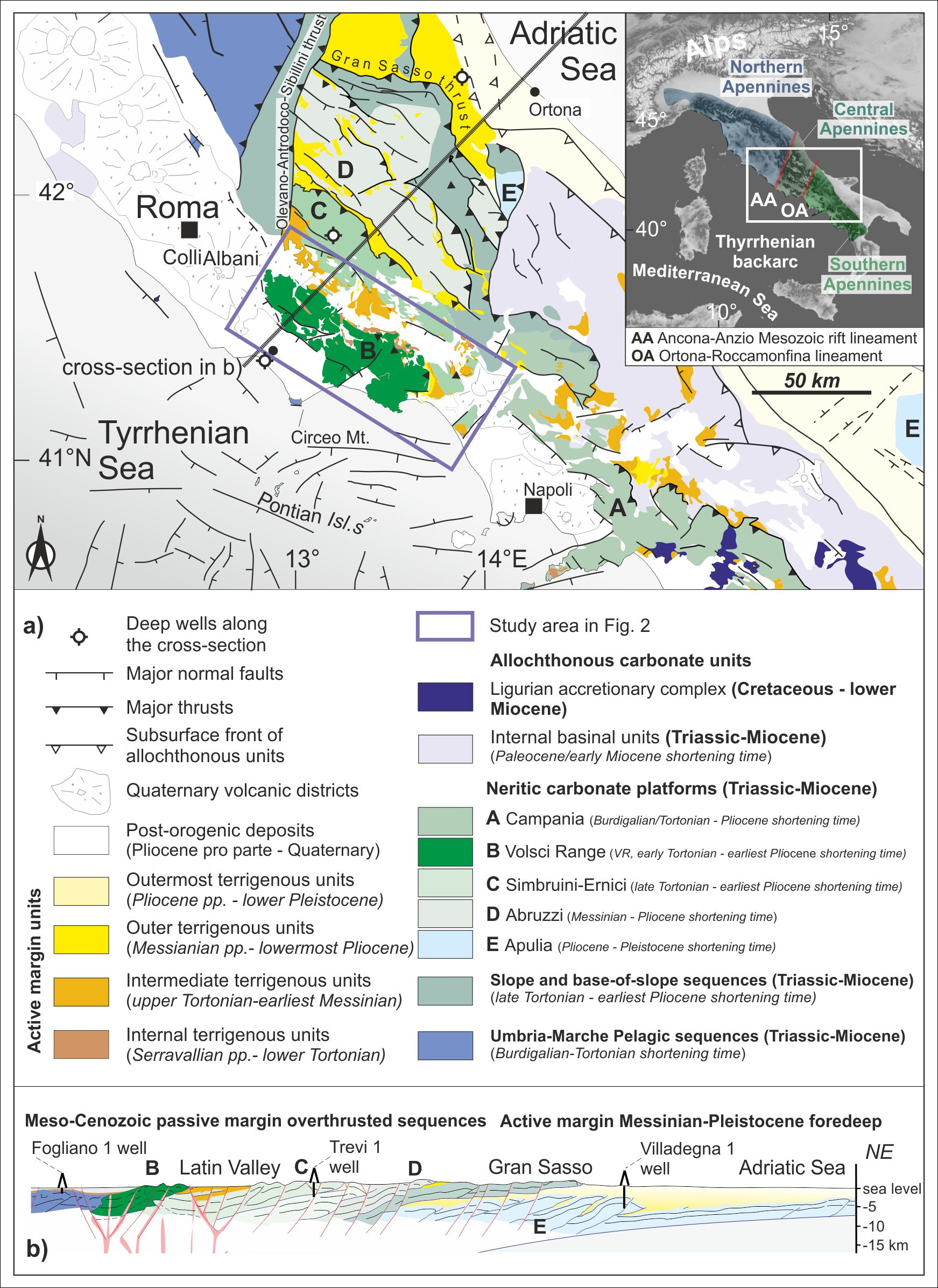
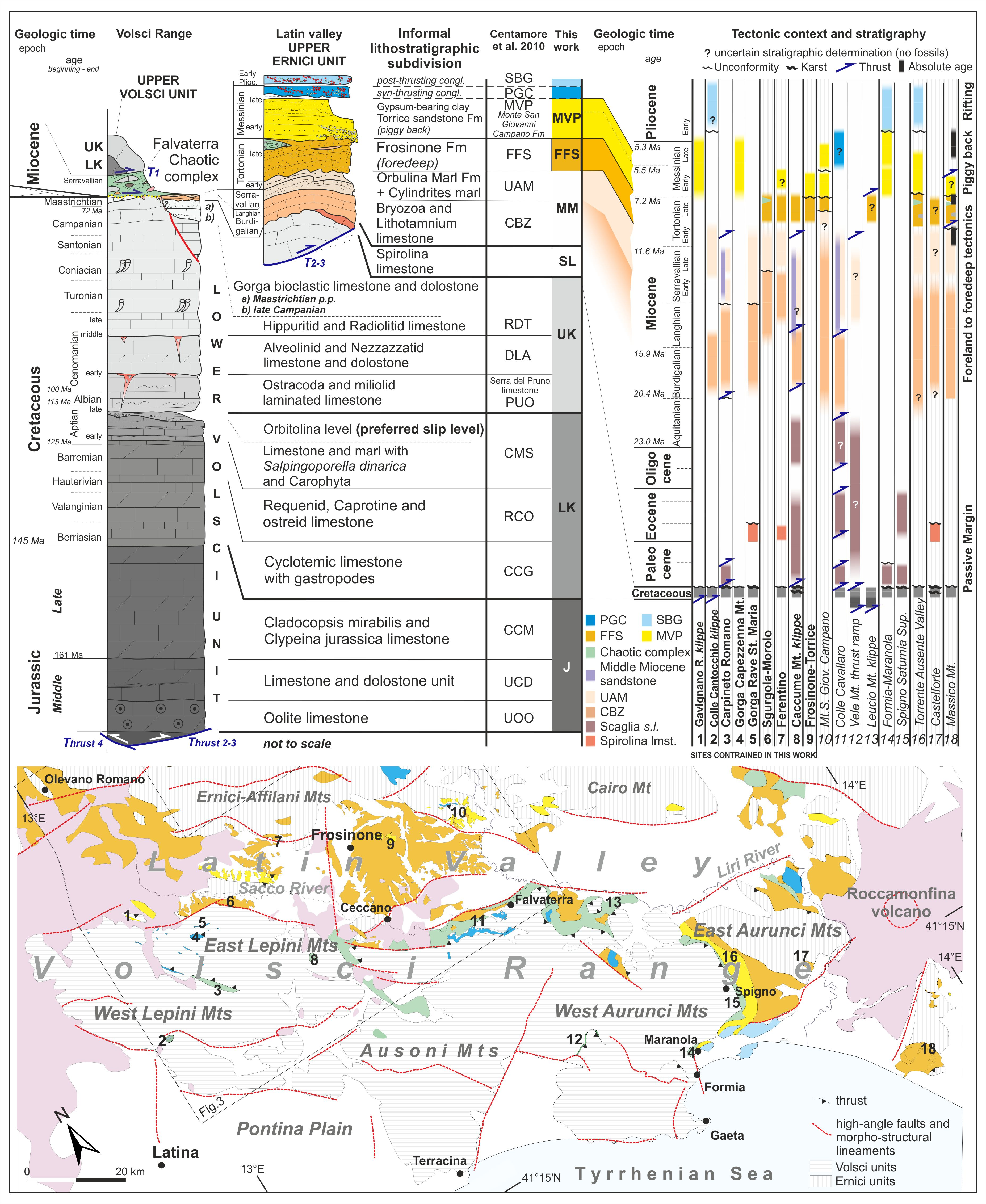
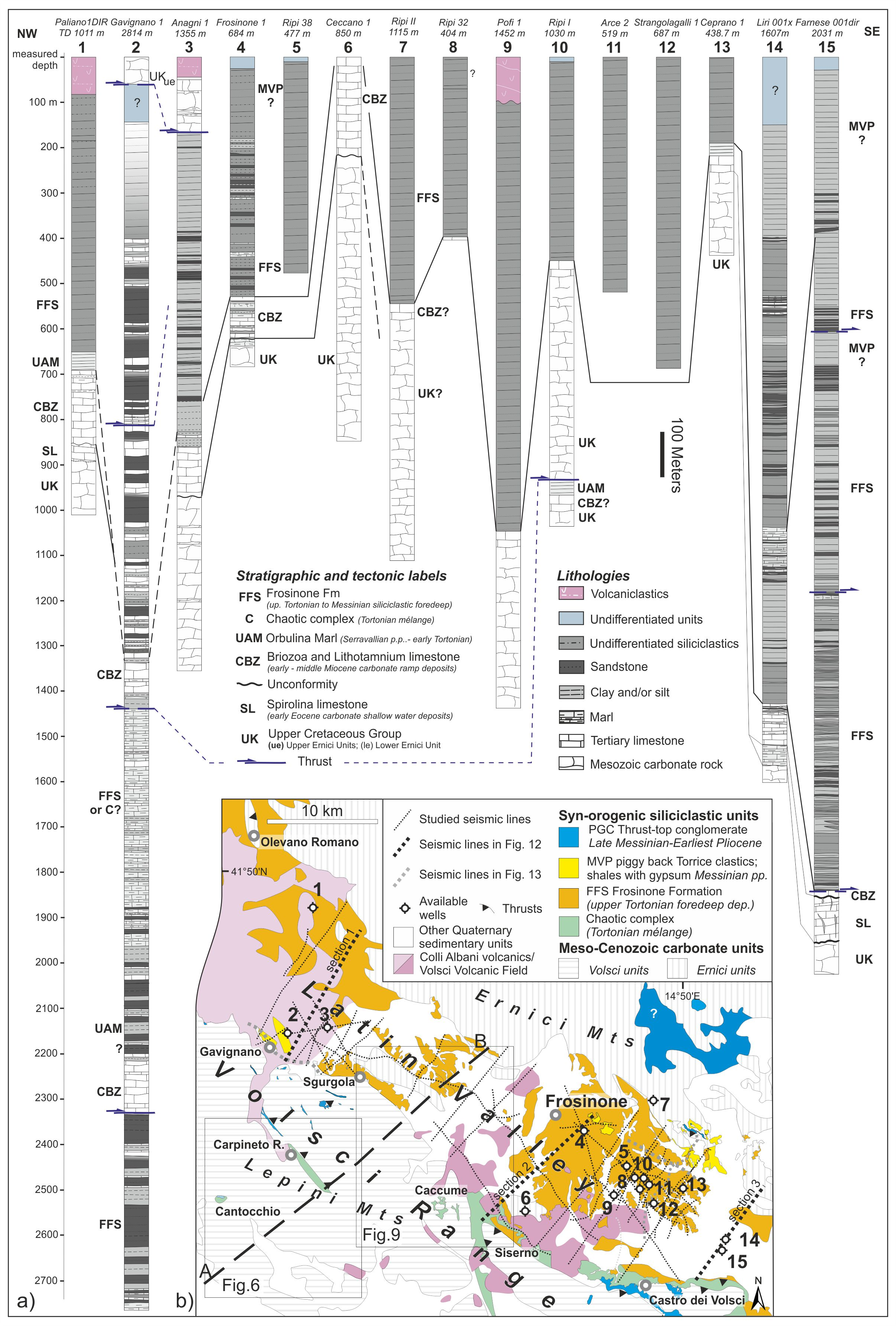
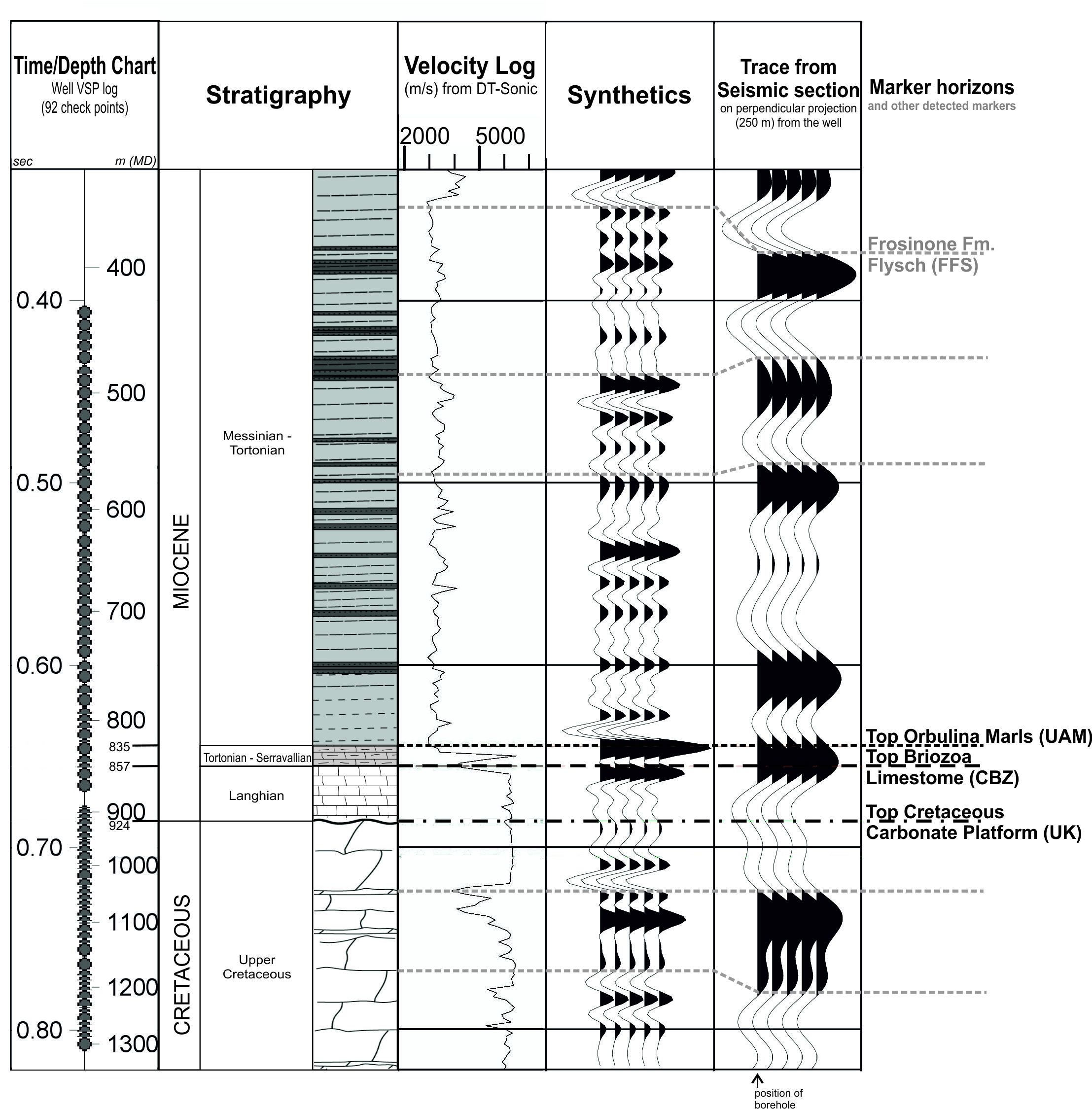
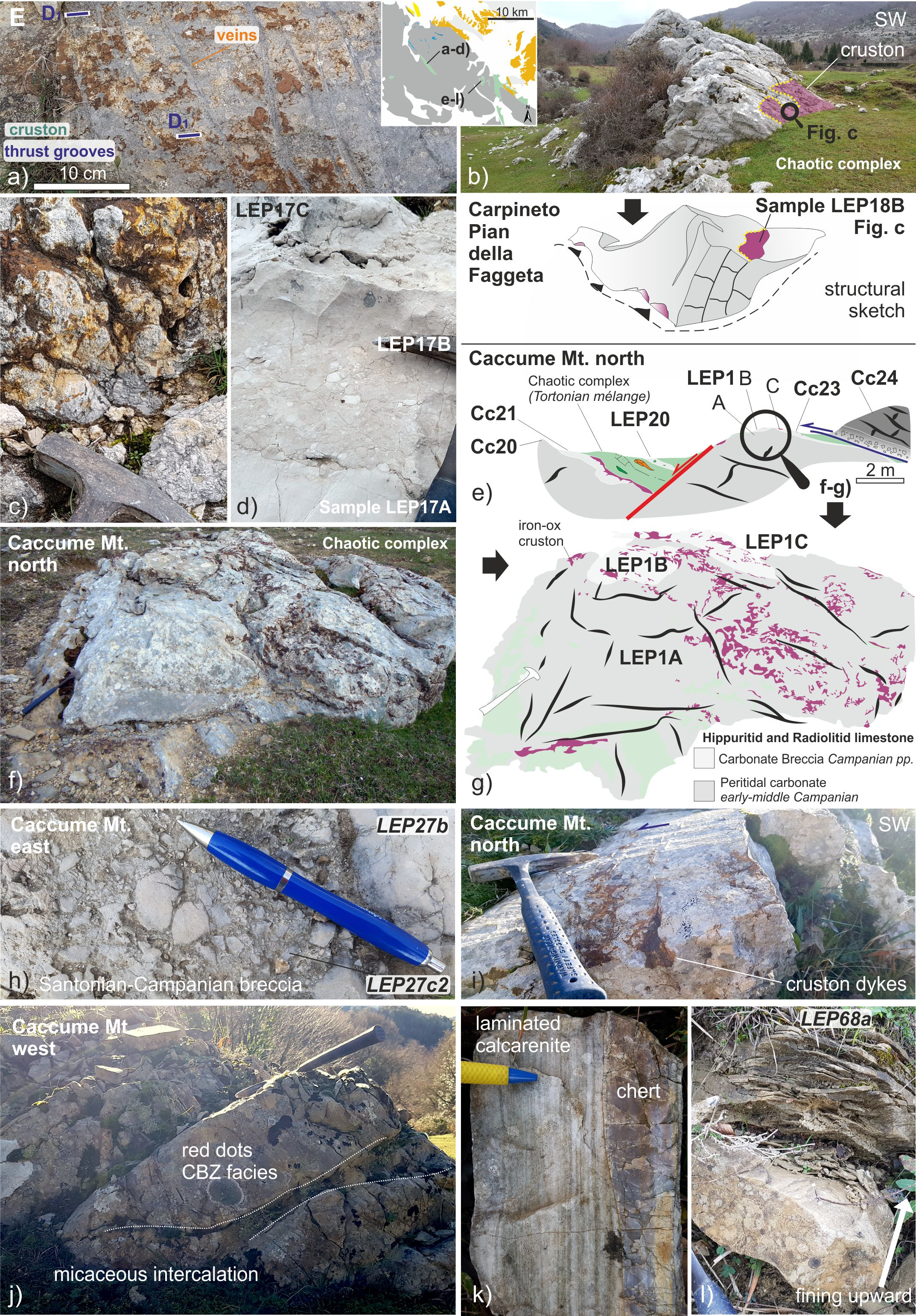
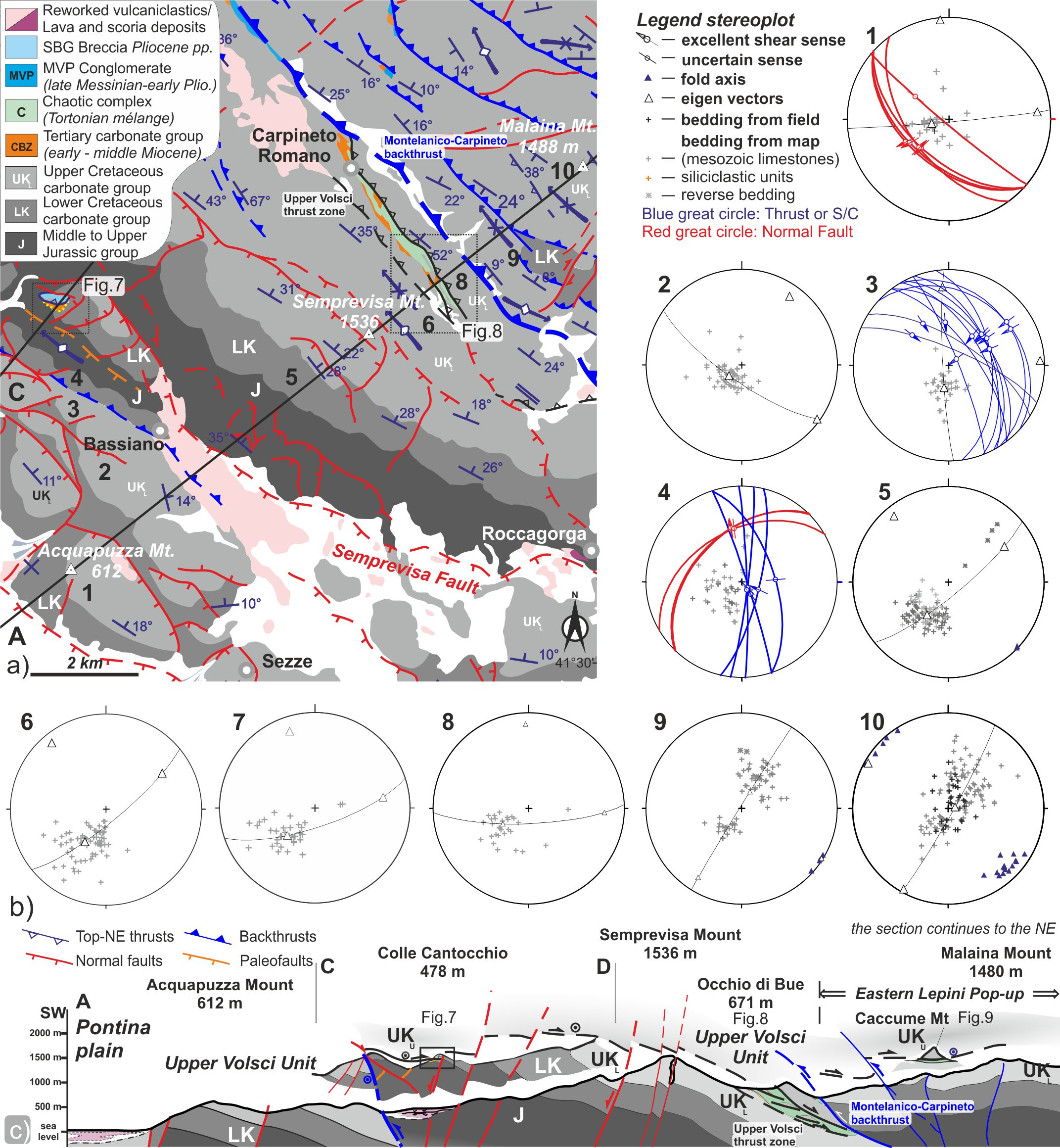
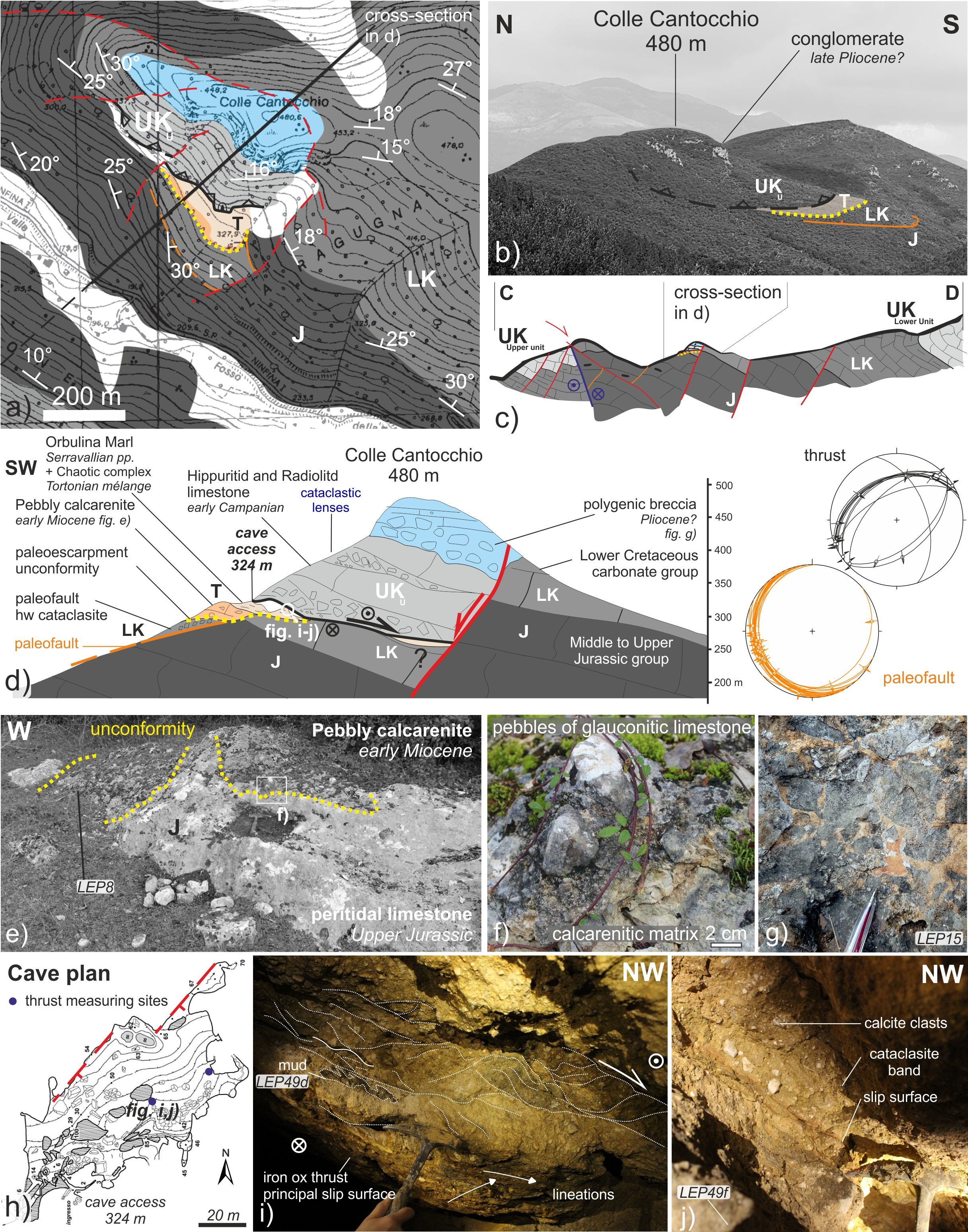
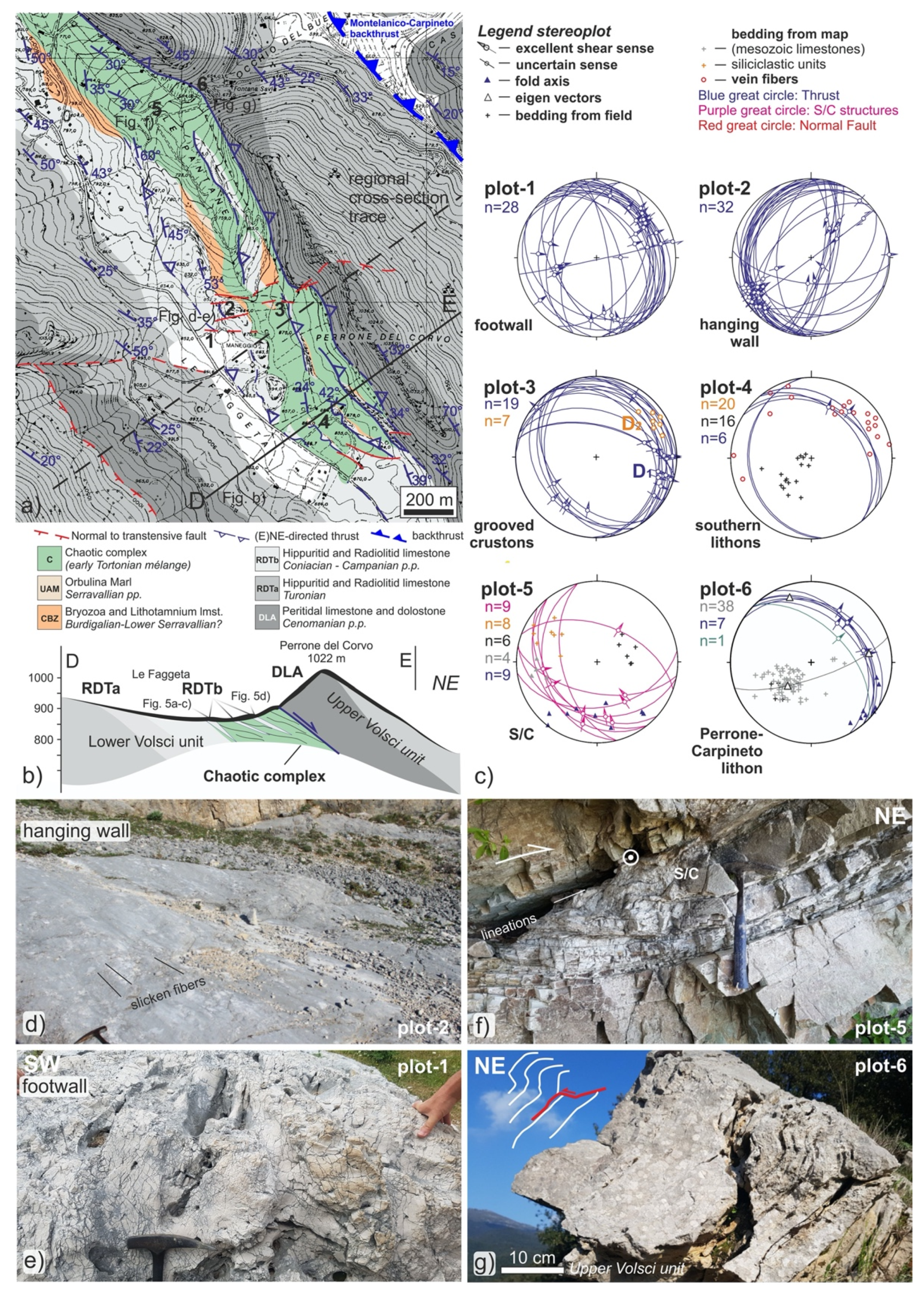
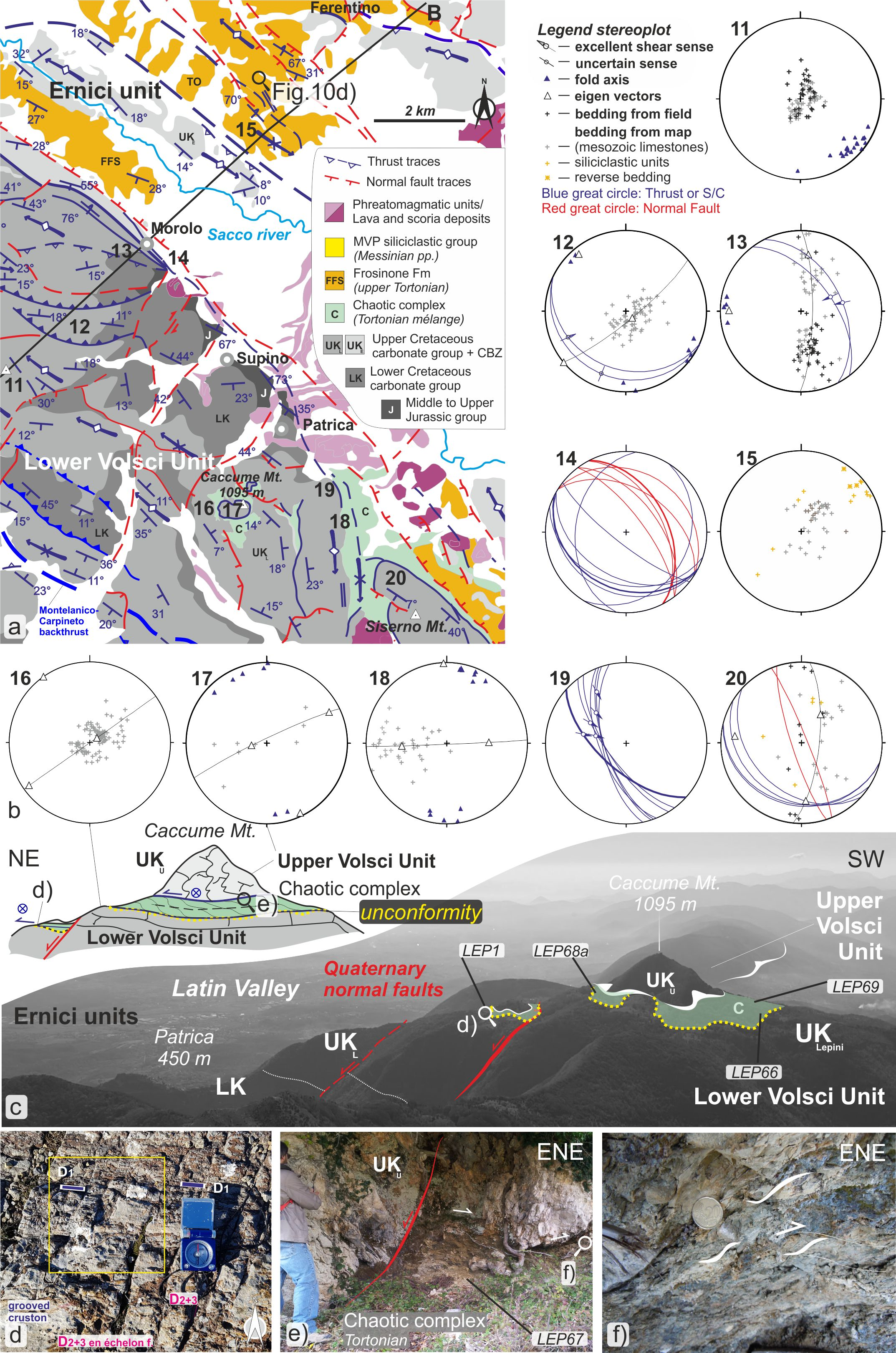
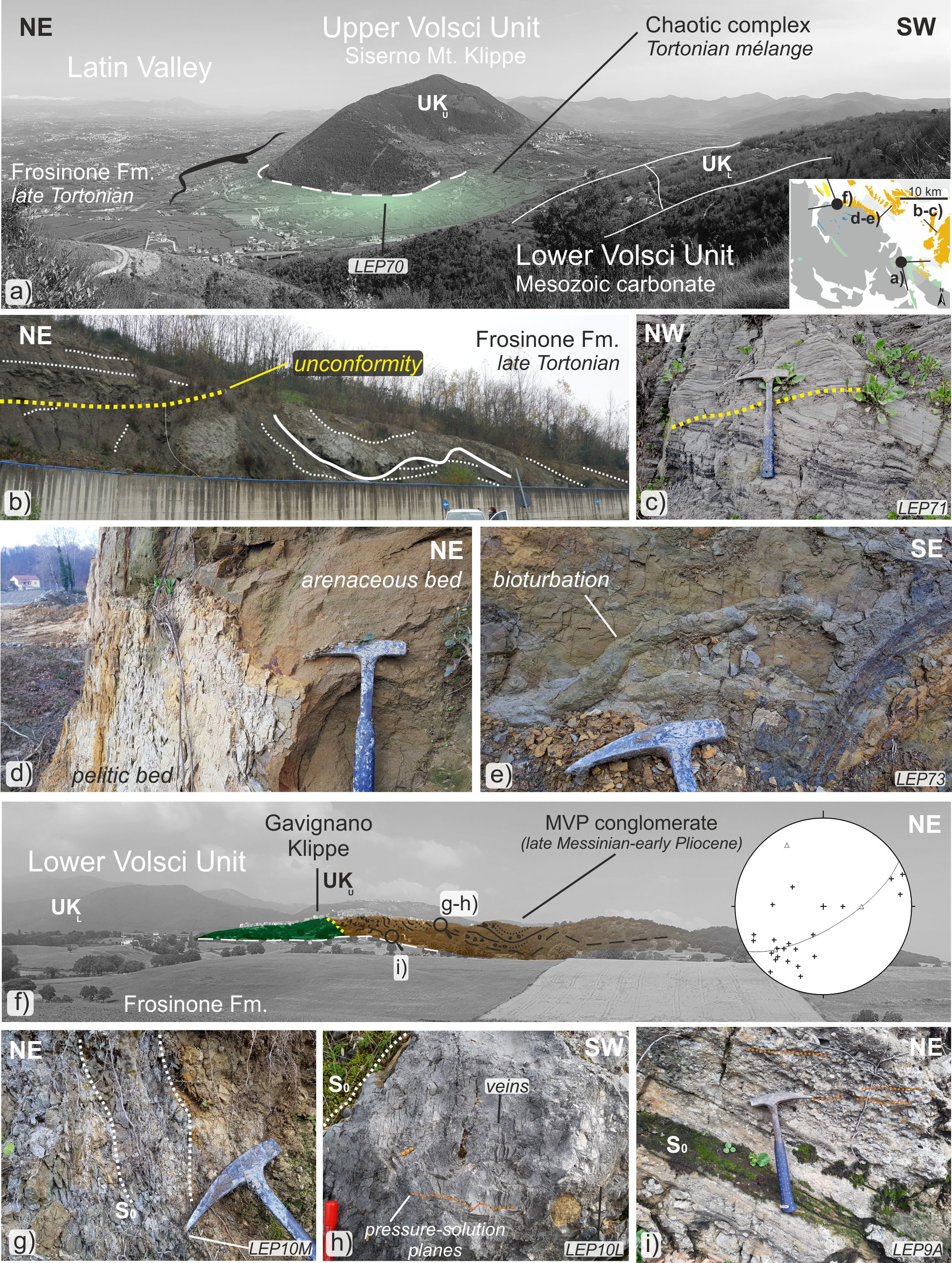
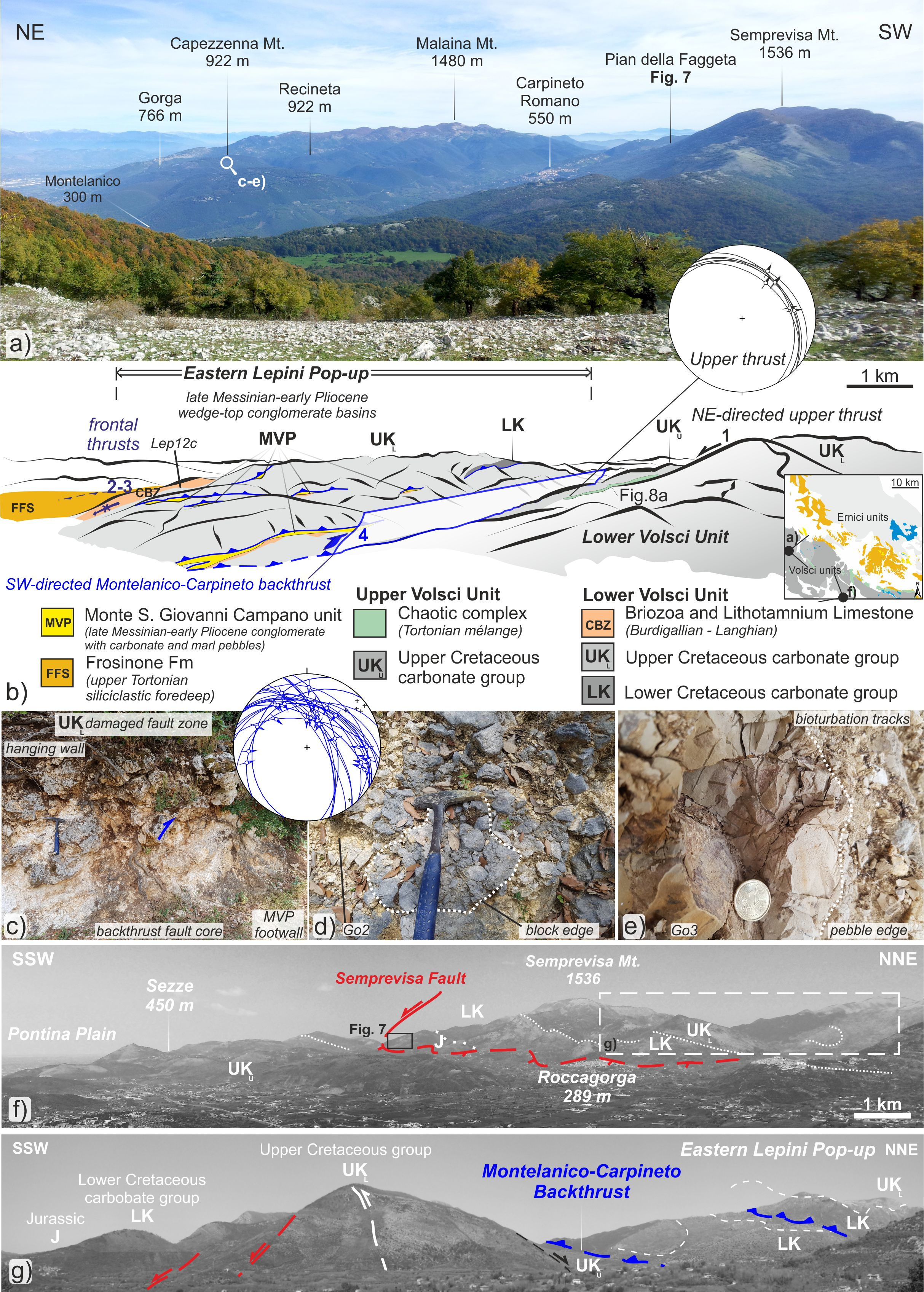
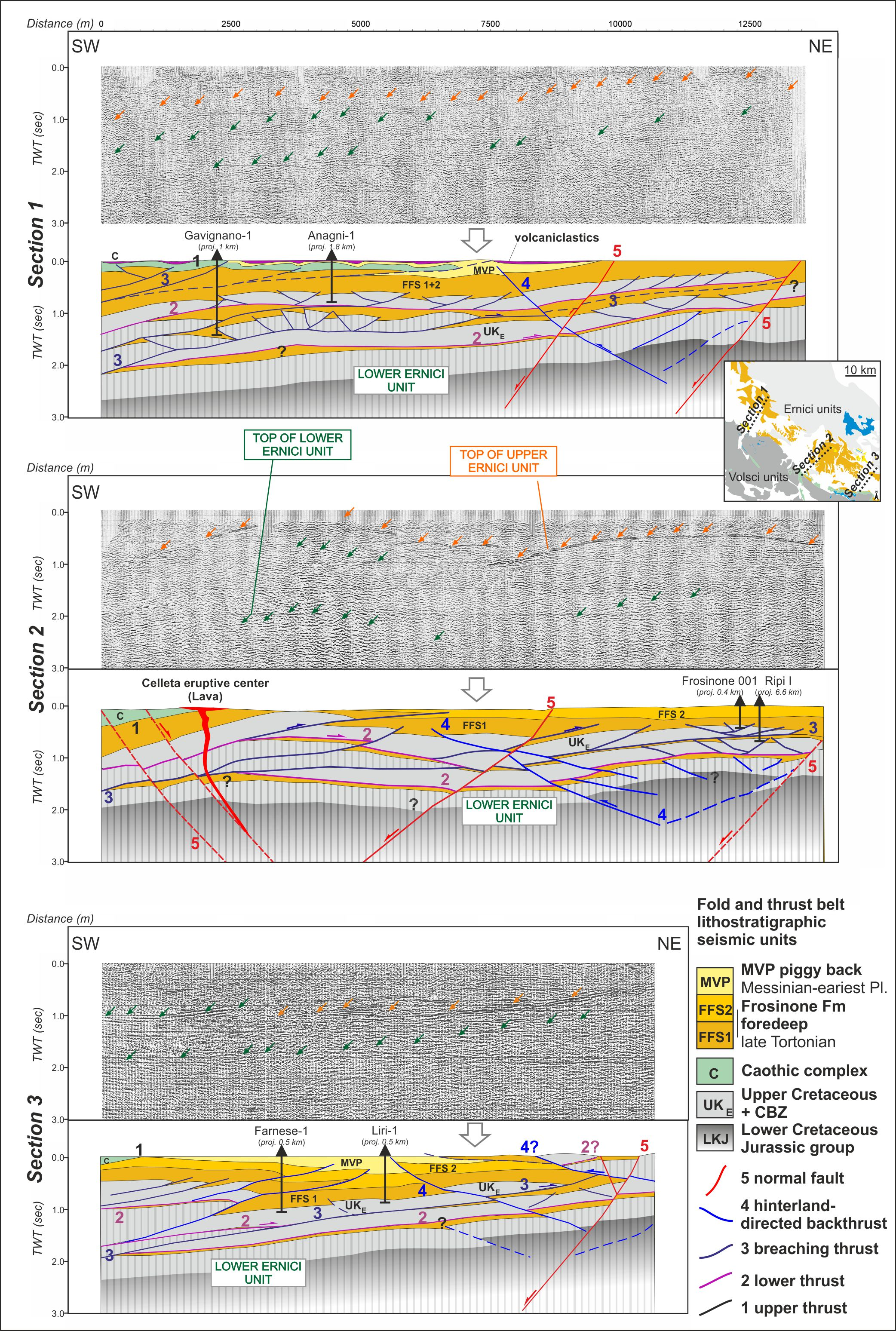


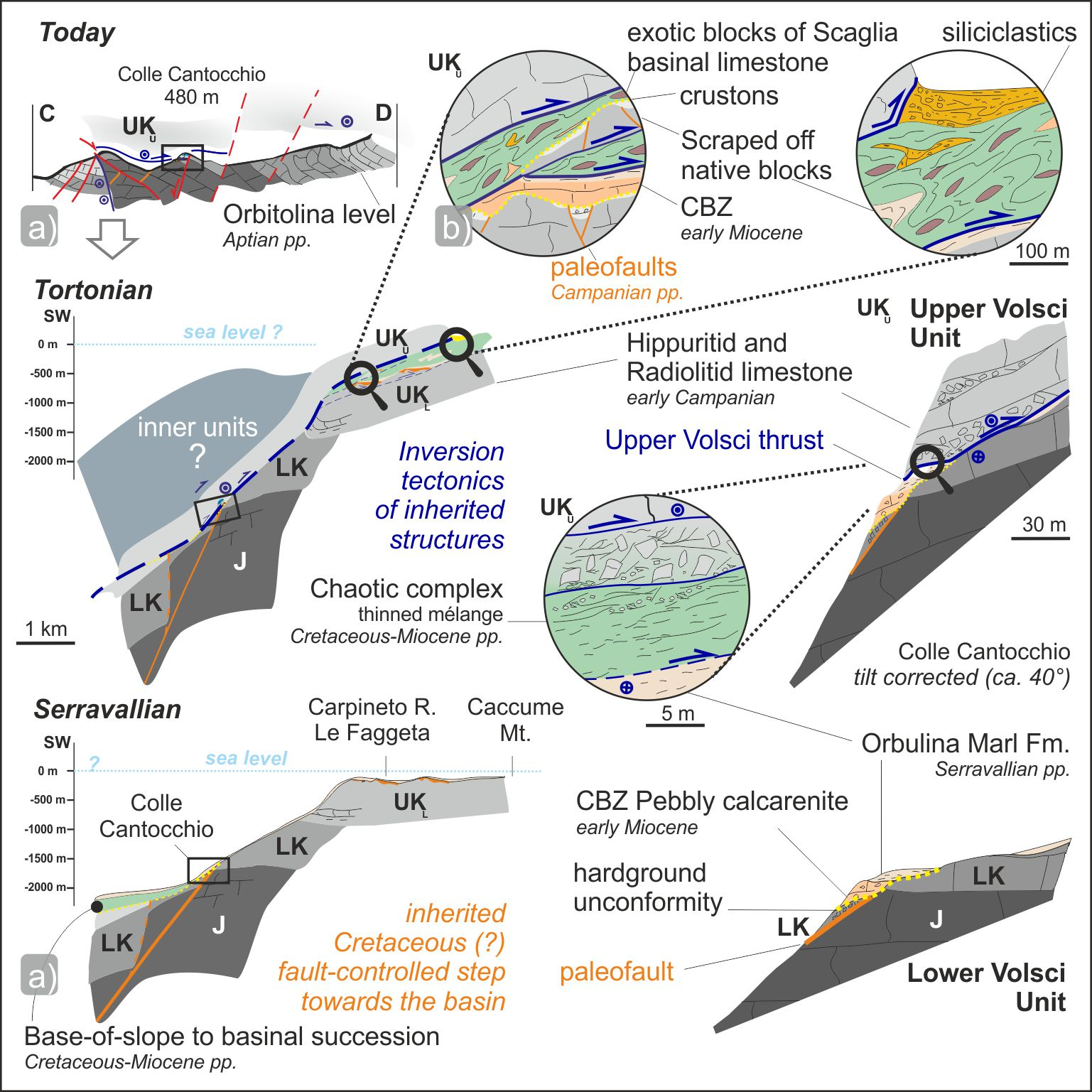
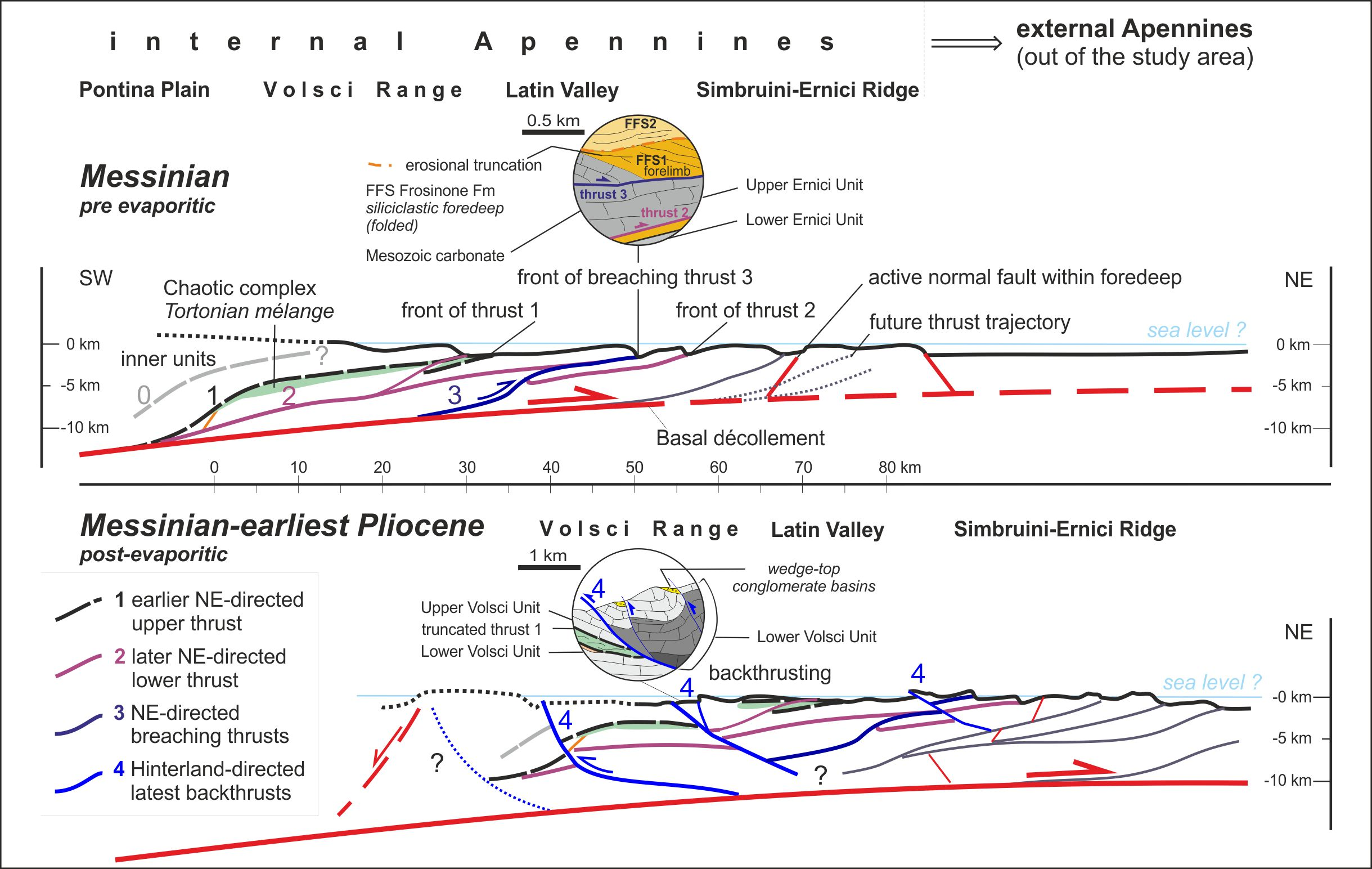
Publisher’s Note: MDPI stays neutral with regard to jurisdictional claims in published maps and institutional affiliations. |
© 2021 by the authors. Licensee MDPI, Basel, Switzerland. This article is an open access article distributed under the terms and conditions of the Creative Commons Attribution (CC BY) license (https://creativecommons.org/licenses/by/4.0/).
Share and Cite
Cardello, G.L.; Vico, G.; Consorti, L.; Sabbatino, M.; Carminati, E.; Doglioni, C. Constraining the Passive to Active Margin Tectonics of the Internal Central Apennines: Insights from Biostratigraphy, Structural, and Seismic Analysis. Geosciences 2021, 11, 160. https://doi.org/10.3390/geosciences11040160
Cardello GL, Vico G, Consorti L, Sabbatino M, Carminati E, Doglioni C. Constraining the Passive to Active Margin Tectonics of the Internal Central Apennines: Insights from Biostratigraphy, Structural, and Seismic Analysis. Geosciences. 2021; 11(4):160. https://doi.org/10.3390/geosciences11040160
Chicago/Turabian StyleCardello, Giovanni Luca, Giuseppe Vico, Lorenzo Consorti, Monia Sabbatino, Eugenio Carminati, and Carlo Doglioni. 2021. "Constraining the Passive to Active Margin Tectonics of the Internal Central Apennines: Insights from Biostratigraphy, Structural, and Seismic Analysis" Geosciences 11, no. 4: 160. https://doi.org/10.3390/geosciences11040160
APA StyleCardello, G. L., Vico, G., Consorti, L., Sabbatino, M., Carminati, E., & Doglioni, C. (2021). Constraining the Passive to Active Margin Tectonics of the Internal Central Apennines: Insights from Biostratigraphy, Structural, and Seismic Analysis. Geosciences, 11(4), 160. https://doi.org/10.3390/geosciences11040160






